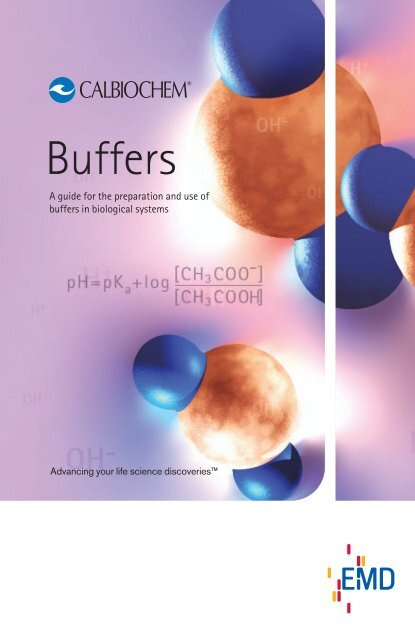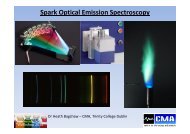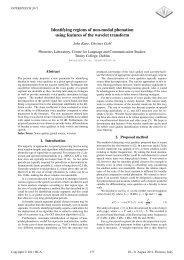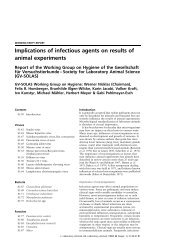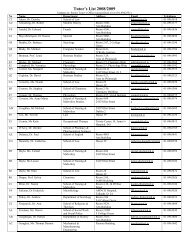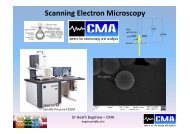A guide for the preparation and use of buffers in biological systems
A guide for the preparation and use of buffers in biological systems
A guide for the preparation and use of buffers in biological systems
You also want an ePaper? Increase the reach of your titles
YUMPU automatically turns print PDFs into web optimized ePapers that Google loves.
Buffers<br />
A <strong>guide</strong> <strong>for</strong> <strong>the</strong> <strong>preparation</strong> <strong>and</strong> <strong>use</strong> <strong>of</strong><br />
<strong>buffers</strong> <strong>in</strong> <strong>biological</strong> <strong>systems</strong><br />
Advanc<strong>in</strong>g your life science discoveries
Buffers<br />
A <strong>guide</strong> <strong>for</strong> <strong>the</strong> <strong>preparation</strong> <strong>and</strong> <strong>use</strong> <strong>of</strong><br />
<strong>buffers</strong> <strong>in</strong> <strong>biological</strong> <strong>systems</strong><br />
By<br />
Ch<strong>and</strong>ra Mohan, Ph.D.<br />
A br<strong>and</strong> <strong>of</strong> EMD Biosciences, Inc.<br />
Copyright © 2003 EMD Biosciences, Inc., An Affiliate <strong>of</strong> Merck KGaA, Darmstadt, Germany.<br />
All Rights Reserved.
A Word to Our Customers<br />
We are pleased to present to you <strong>the</strong> newest edition <strong>of</strong> Buffers: A Guide <strong>for</strong> <strong>the</strong><br />
Preparation <strong>and</strong> Use <strong>of</strong> Buffers <strong>in</strong> Biological Systems. This practical resource has<br />
been especially revamped <strong>for</strong> <strong>use</strong> by researchers <strong>in</strong> <strong>the</strong> <strong>biological</strong> sciences. This<br />
publication is a part <strong>of</strong> our cont<strong>in</strong>u<strong>in</strong>g commitment to provide <strong>use</strong>ful product<br />
<strong>in</strong><strong>for</strong>mation <strong>and</strong> exceptional service to you, our customers. You will f<strong>in</strong>d this<br />
booklet a highly <strong>use</strong>ful resource, whe<strong>the</strong>r you are just beg<strong>in</strong>n<strong>in</strong>g your research<br />
work or tra<strong>in</strong><strong>in</strong>g <strong>the</strong> newest researchers <strong>in</strong> your laboratory.<br />
Over <strong>the</strong> past several years, Calbiochem® Biochemicals has clearly emerged as a<br />
world leader <strong>in</strong> provid<strong>in</strong>g highly <strong>in</strong>novative products <strong>for</strong> your research needs <strong>in</strong><br />
Signal Transduction, <strong>in</strong>clud<strong>in</strong>g <strong>the</strong> areas <strong>of</strong> Cancer Biology, Alzheimer’s Disease,<br />
Diabetes <strong>and</strong> Hypertension, Prote<strong>in</strong> K<strong>in</strong>ase, G-Prote<strong>in</strong>, Apoptosis, <strong>and</strong> Nitric<br />
Oxide related phenomena. Please call us today <strong>for</strong> a free copy <strong>of</strong> our LATEST<br />
Signal Transduction Catalog <strong>and</strong> Technical Resource <strong>and</strong>/or our Apoptosis<br />
Catalog.<br />
If you have <strong>use</strong>d Calbiochem® products <strong>in</strong> <strong>the</strong> past, we thank you <strong>for</strong> your<br />
support <strong>and</strong> confidence <strong>in</strong> our products, <strong>and</strong> if you are just beg<strong>in</strong>n<strong>in</strong>g your<br />
research career, please call us <strong>and</strong> give us <strong>the</strong> opportunity to demonstrate our<br />
exceptional customer <strong>and</strong> technical service.<br />
Please call us <strong>and</strong> ask <strong>for</strong> a current list<strong>in</strong>g <strong>of</strong> our ever exp<strong>and</strong><strong>in</strong>g Technical<br />
Resource Library, now with over 60 Calbiochem® publications. Or check out our<br />
website at http://www.calbiochem.com <strong>for</strong> even more <strong>use</strong>ful <strong>in</strong><strong>for</strong>mation.<br />
Marie Bergstrom<br />
Market<strong>in</strong>g Manager<br />
CALBIOCHEM® <strong>and</strong> Oncogene Research Products<br />
CALBIOCHEM ®<br />
A name synonymous with commitment to high quality <strong>and</strong> exceptional service.<br />
ii
Table <strong>of</strong> Contents:<br />
Why Does Calbiochem® Biochemicals Publish a Booklet on Buffers? . . . . . . . . . .1<br />
Water, The Fluid <strong>of</strong> Life . . . . . . . . . . . . . . . . . . . . . . . . . . . . . . . . . . . . . . . . . . . . . .2<br />
Ionization <strong>of</strong> Water . . . . . . . . . . . . . . . . . . . . . . . . . . . . . . . . . . . . . . . . . . . . . . . . . .3<br />
Dissociation Constants <strong>of</strong> Weak Acids <strong>and</strong> Bases . . . . . . . . . . . . . . . . . . . . . . . . . .4<br />
Henderson-Hasselbach Equation: pH <strong>and</strong> pK a<br />
. . . . . . . . . . . . . . . . . . . . . . . . . . . . .5<br />
Determ<strong>in</strong>ation <strong>of</strong> pK a<br />
. . . . . . . . . . . . . . . . . . . . . . . . . . . . . . . . . . . . . . . . . . . . . . . . .6<br />
pK a<br />
Values <strong>for</strong> Commonly Used Biological Buffers . . . . . . . . . . . . . . . . . . . . . . . . .7<br />
Buffers, Buffer Capacity, <strong>and</strong> Range . . . . . . . . . . . . . . . . . . . . . . . . . . . . . . . . . . . . .8<br />
Biological Buffers . . . . . . . . . . . . . . . . . . . . . . . . . . . . . . . . . . . . . . . . . . . . . . . . . . .10<br />
Buffer<strong>in</strong>g <strong>in</strong> Cells <strong>and</strong> Tissues . . . . . . . . . . . . . . . . . . . . . . . . . . . . . . . . . . . . . . . . .10<br />
Effect <strong>of</strong> Temperature on pH . . . . . . . . . . . . . . . . . . . . . . . . . . . . . . . . . . . . . . . . . .12<br />
Effect <strong>of</strong> Buffers on Factors O<strong>the</strong>r than pH . . . . . . . . . . . . . . . . . . . . . . . . . . . . . .13<br />
Use <strong>of</strong> Water-Miscible Organic Solvents . . . . . . . . . . . . . . . . . . . . . . . . . . . . . . . .14<br />
Solubility Equilibrium: Effect <strong>of</strong> pH on Solubility . . . . . . . . . . . . . . . . . . . . . . . .14<br />
pH Measurements: Some Useful Tips . . . . . . . . . . . . . . . . . . . . . . . . . . . . . . . . . . .15<br />
Choos<strong>in</strong>g a Buffer . . . . . . . . . . . . . . . . . . . . . . . . . . . . . . . . . . . . . . . . . . . . . . . . . .16<br />
Preparation <strong>of</strong> Some Common Buffers <strong>for</strong> Use<br />
<strong>in</strong> Biological Systems . . . . . . . . . . . . . . . . . . . . . . . . . . . . . . . . . . . . . . . . . . . . . . .18<br />
Commonly Used Buffer Media <strong>in</strong> Biological Research . . . . . . . . . . . . . . . . . . . . .22<br />
Isoelectric Po<strong>in</strong>t <strong>of</strong> Selected Prote<strong>in</strong>s . . . . . . . . . . . . . . . . . . . . . . . . . . . . . . . . . . .24<br />
Isoelectric Po<strong>in</strong>t <strong>of</strong> Selected Plasma Prote<strong>in</strong>s . . . . . . . . . . . . . . . . . . . . . . . . . . . .26<br />
Approximate pH <strong>and</strong> Bicarbonate Concentration <strong>in</strong><br />
Extracellular Fluids . . . . . . . . . . . . . . . . . . . . . . . . . . . . . . . . . . . . . . . . . . . . . . . . .26<br />
Ionization Constants K <strong>and</strong> pK a<br />
<strong>for</strong> Selected Acids <strong>and</strong><br />
Bases <strong>in</strong> Water . . . . . . . . . . . . . . . . . . . . . . . . . . . . . . . . . . . . . . . . . . . . . . . . . . . . .27<br />
Physical Properties <strong>of</strong> Some Commonly Used Acids . . . . . . . . . . . . . . . . . . . . . . .27<br />
Some Useful Tips <strong>for</strong> Calculation <strong>of</strong> Concentrations <strong>and</strong><br />
Spectrophotometric Measurements . . . . . . . . . . . . . . . . . . . . . . . . . . . . . . . . . . . .28<br />
CALBIOCHEM® Buffers . . . . . . . . . . . . . . . . . . . . . . . . . . . . . . . . . . . . . . . . . . . . . .30<br />
iii
Why Does Calbiochem® Biochemicals Publish a<br />
Booklet on Buffers?<br />
We are frequently asked questions on <strong>the</strong> <strong>use</strong> <strong>of</strong> <strong>buffers</strong> that we <strong>of</strong>fer to research<br />
laboratories. This booklet is designed to help answer several basic questions<br />
about <strong>the</strong> <strong>use</strong> <strong>of</strong> <strong>buffers</strong> <strong>in</strong> <strong>biological</strong> <strong>systems</strong>. The discussion presented here is<br />
by no means complete, but we hope it will help <strong>in</strong> <strong>the</strong> underst<strong>and</strong><strong>in</strong>g <strong>of</strong> general<br />
pr<strong>in</strong>ciples <strong>in</strong>volved <strong>in</strong> <strong>the</strong> <strong>use</strong> <strong>of</strong> <strong>buffers</strong>.<br />
Almost all <strong>biological</strong> processes are pH dependent. Even a slight change <strong>in</strong> pH can<br />
result <strong>in</strong> metabolic acidosis or alkalosis, result<strong>in</strong>g <strong>in</strong> severe metabolic complications.<br />
The purpose <strong>of</strong> a buffer <strong>in</strong> <strong>biological</strong> system is to ma<strong>in</strong>ta<strong>in</strong> <strong>in</strong>tracellular<br />
<strong>and</strong> extracellular pH with<strong>in</strong> a very narrow range <strong>and</strong> resist changes <strong>in</strong> pH <strong>in</strong> <strong>the</strong><br />
presence <strong>of</strong> <strong>in</strong>ternal <strong>and</strong> external <strong>in</strong>fluences. Be<strong>for</strong>e we beg<strong>in</strong> a discussion <strong>of</strong><br />
<strong>buffers</strong> <strong>and</strong> how <strong>the</strong>y control hydrogen ion concentrations, a brief explanation<br />
<strong>of</strong> <strong>the</strong> role <strong>of</strong> water <strong>and</strong> equilibrium constants <strong>of</strong> weak acids <strong>and</strong> bases is<br />
necessary.<br />
1
Water: The Fluid <strong>of</strong> Life<br />
Water constitutes about 70% <strong>of</strong> <strong>the</strong> mass <strong>of</strong> most liv<strong>in</strong>g creatures. All <strong>biological</strong><br />
reactions occur <strong>in</strong> an aqueous medium. All aspects <strong>of</strong> cell structure <strong>and</strong> function<br />
are adapted to <strong>the</strong> physical <strong>and</strong> chemical properties <strong>of</strong> water. Hence, it is<br />
essential to underst<strong>and</strong> some basic properties <strong>of</strong> water <strong>and</strong> its ionization<br />
products, i.e., H + <strong>and</strong> OH¯. Both H + <strong>and</strong> OH¯ <strong>in</strong>fluence <strong>the</strong> structure, assembly,<br />
<strong>and</strong> properties <strong>of</strong> all macromolecules <strong>in</strong> <strong>the</strong> cell.<br />
Water is a polar solvent that dissolves most charged molecules. Water dissolves<br />
most salts by hydrat<strong>in</strong>g <strong>and</strong> stabiliz<strong>in</strong>g <strong>the</strong> cations <strong>and</strong> anions by weaken<strong>in</strong>g<br />
<strong>the</strong>ir electrostatic <strong>in</strong>teractions (Figure 1). Compounds that readily dissolve <strong>in</strong><br />
water are known as HYDROPHILIC compounds. Nonpolar compounds such as<br />
chloro<strong>for</strong>m <strong>and</strong> e<strong>the</strong>r do not <strong>in</strong>teract with water <strong>in</strong> any favorable manner <strong>and</strong> are<br />
known as HYDROPHOBIC compounds. These compounds <strong>in</strong>terfere with<br />
hydrogen bond<strong>in</strong>g among water molecules.<br />
Figure 1: Electrostatic <strong>in</strong>teraction <strong>of</strong> Na + <strong>and</strong> Cl¯ ions <strong>and</strong> water molecules.<br />
Several <strong>biological</strong> molecules, such as prote<strong>in</strong>, certa<strong>in</strong> vitam<strong>in</strong>s, steroids, <strong>and</strong><br />
phospholipids conta<strong>in</strong> both polar <strong>and</strong> nonpolar regions. They are known as<br />
AMPHIPATHIC molecules. The hydrophilic region <strong>of</strong> <strong>the</strong>se molecules are<br />
arranged <strong>in</strong> a manner that permits maximum <strong>in</strong>teraction with water molecules.<br />
However, <strong>the</strong> hydrophobic regions assemble toge<strong>the</strong>r expos<strong>in</strong>g only <strong>the</strong> smallest<br />
area to water.<br />
2
Ionization <strong>of</strong> Water<br />
Water molecules undergo reversible ionization to yield H + <strong>and</strong> OH¯ as per <strong>the</strong><br />
follow<strong>in</strong>g equation.<br />
H 2<br />
O → ← H + + OH¯<br />
The degree <strong>of</strong> ionization <strong>of</strong> water at equilibrium is fairly small <strong>and</strong> is given by<br />
<strong>the</strong> follow<strong>in</strong>g equation where K eq<br />
is <strong>the</strong> equilibrium constant.<br />
K eq<br />
[H + ][OH¯]<br />
= ______________<br />
[H 2<br />
O]<br />
At 25°C, <strong>the</strong> concentration <strong>of</strong> pure water is 55.5 M (1000 ÷ 18; M.W. 18.0).<br />
Hence, we can rewrite <strong>the</strong> above equation as follows:<br />
K eq<br />
[H + ][OH¯]<br />
= ______________<br />
55.5 M<br />
or<br />
(55.5)(K eq<br />
) = [H+][OH¯]<br />
For pure water electrical conductivity experiments give a K eq<br />
value <strong>of</strong> 1.8 x<br />
10 -16 M at 25°C.<br />
Hence,<br />
(55.5 M)(1.8 x 10 -16 M) = [H + ][OH¯]<br />
or<br />
99.9 x 10 -16 M 2 = [H + ][OH¯]<br />
or<br />
1.0 x 10 -14 M 2 = [H + ][OH¯]<br />
[H + ][OH¯], ion product <strong>of</strong> water, is always equal to 1.0 x 10 -14 M 2 at 25°C. When<br />
[H + ] <strong>and</strong> [OH¯] are present <strong>in</strong> equal amounts <strong>the</strong>n <strong>the</strong> solution gives a neutral pH.<br />
Here [H + ][OH¯] = [H + ] 2<br />
or<br />
[H + ] = 1 x 10 -14 M 2<br />
<strong>and</strong><br />
[H + ] = [OH¯] = 10 -7 M<br />
As <strong>the</strong> total concentration <strong>of</strong> H + <strong>and</strong> OH¯ is constant, an <strong>in</strong>crease <strong>in</strong> one ion is<br />
compensated by a decrease <strong>in</strong> <strong>the</strong> concentration <strong>of</strong> o<strong>the</strong>r ion. This <strong>for</strong>ms <strong>the</strong><br />
basis <strong>for</strong> <strong>the</strong> pH scale.<br />
3
Dissociation Constants <strong>of</strong> Weak Acids <strong>and</strong> Bases<br />
Strong acids (hydrochloric acid, sulfuric acid, etc.) <strong>and</strong> bases (sodium hydroxide,<br />
potassium hydroxide, etc.) are those that are completely ionized <strong>in</strong> dilute<br />
aqueous solutions.<br />
In <strong>biological</strong> <strong>systems</strong> one generally encounters only weak acids <strong>and</strong> bases. Weak<br />
acids <strong>and</strong> bases do not completely dissociate <strong>in</strong> solution. They exist <strong>in</strong>stead as an<br />
equilibrium mixture <strong>of</strong> undissociated <strong>and</strong> dissociated species. For example, <strong>in</strong><br />
aqueous solution, acetic acid is an equilibrium mixture <strong>of</strong> acetate ion, hydrogen<br />
ion, <strong>and</strong> undissociated acetic acid. The equilibrium between <strong>the</strong>se species can be<br />
expressed as:<br />
CH 3<br />
COOH<br />
k 1<br />
→ ←<br />
H + + CH 3<br />
COO¯<br />
k 2<br />
where k 1<br />
represents <strong>the</strong> rate constant <strong>of</strong> dissociation <strong>of</strong> acetic acid to acetate <strong>and</strong><br />
hydrogen ions, <strong>and</strong> k 2<br />
represents <strong>the</strong> rate constant <strong>for</strong> <strong>the</strong> association <strong>of</strong> acetate<br />
<strong>and</strong> hydrogen ions to <strong>for</strong>m acetic acid. The rate <strong>of</strong> dissociation <strong>of</strong> acetic acid,<br />
-d[CH 3<br />
COOH ]/dt, is dependent on <strong>the</strong> rate constant <strong>of</strong> dissociation (k 1<br />
) <strong>and</strong> <strong>the</strong><br />
concentration <strong>of</strong> acetic acid [CH 3<br />
COOH] <strong>and</strong> can be expressed as:<br />
____________________<br />
d [CH 3<br />
COOH]<br />
dt<br />
= k 1<br />
[CH 3<br />
COOH]<br />
Similarly, <strong>the</strong> rate <strong>of</strong> association to <strong>for</strong>m acetic acid, d[HAc]/dt, is dependent on<br />
<strong>the</strong> rate constant <strong>of</strong> association (k 2<br />
) <strong>and</strong> <strong>the</strong> concentration <strong>of</strong> acetate <strong>and</strong><br />
hydrogen ions <strong>and</strong> can be expressed as:<br />
d [CH 3<br />
COOH ]<br />
__________________<br />
dt<br />
= k 2<br />
[H + ] [CH 3<br />
COO¯]<br />
S<strong>in</strong>ce <strong>the</strong> rates <strong>of</strong> dissociation <strong>and</strong> reassociation are equal under equilibrium<br />
conditions:<br />
k 1<br />
[CH 3<br />
COOH ] = k 2<br />
[H + ] [CH 3<br />
COO¯]<br />
or<br />
k 1<br />
[H + ] [CH 3<br />
COO¯]<br />
_______ = ____________________<br />
[CH 3<br />
COOH]<br />
<strong>and</strong><br />
where<br />
4<br />
k 2<br />
k _______ 1<br />
k 2<br />
[H + ] [CH 3<br />
COO¯]<br />
K a<br />
= ___________________<br />
[CH 3<br />
COOH]<br />
=K a<br />
(Equilibrium constant)
This equilibrium expression can now be rearranged to<br />
[CH 3<br />
COOH]<br />
[H + ] = K a<br />
_______________<br />
[CH 3<br />
COO¯]<br />
where <strong>the</strong> hydrogen ion concentration is expressed <strong>in</strong> terms <strong>of</strong> <strong>the</strong> equilibrium<br />
constant <strong>and</strong> <strong>the</strong> concentrations <strong>of</strong> undissociated acetic acid <strong>and</strong> acetate ion. The<br />
equilibrium constant <strong>for</strong> ionization reactions is called <strong>the</strong> ionization constant or<br />
dissociation constant.<br />
Henderson-Hasselbach Equation: pH <strong>and</strong> pK a<br />
The relationship between pH, pK a<br />
, <strong>and</strong> <strong>the</strong> buffer<strong>in</strong>g action <strong>of</strong> any weak acid <strong>and</strong><br />
its conjugate base is best expla<strong>in</strong>ed by <strong>the</strong> Henderson-Hasselbach equation. In<br />
<strong>biological</strong> experiments, [H + ] varies from 10 -1 M to about 10 -10 M. S.P.L.<br />
Sorenson, a Danish chemist, co<strong>in</strong>ed <strong>the</strong> “p” value <strong>of</strong> any quantity as <strong>the</strong> negative<br />
logarithm <strong>of</strong> <strong>the</strong> hydrogen ion concentration. Hence, <strong>for</strong> [H + ] one can write <strong>the</strong><br />
follow<strong>in</strong>g equation:<br />
pH = – log [H + ]<br />
Similarly pK a<br />
can be def<strong>in</strong>ed as – log K a<br />
. If <strong>the</strong> equilibrium expression is<br />
converted to – log <strong>the</strong>n<br />
[CH 3<br />
COOH]<br />
– log [H + ] = – log K a<br />
– log ______________<br />
[CH 3<br />
COO¯]<br />
<strong>and</strong> pH <strong>and</strong> pK a<br />
substituted:<br />
[CH 3<br />
COOH]<br />
pH = pK a<br />
– log ________________<br />
[CH 3<br />
COO¯]<br />
pH =<br />
or<br />
[CH 3<br />
COO¯]<br />
pK a<br />
+ log _______________<br />
[CH 3<br />
COOH]<br />
When <strong>the</strong> concentration <strong>of</strong> acetate ions equals <strong>the</strong> concentration <strong>of</strong> acetic acid,<br />
log [CH 3<br />
COO¯]/[CH 3<br />
COOH] approaches zero (<strong>the</strong> log <strong>of</strong> 1) <strong>and</strong> pH equals pK a<br />
(<strong>the</strong><br />
pK a<br />
<strong>of</strong> acetic acid is 4.745). Acetic acid <strong>and</strong> acetate ion <strong>for</strong>m an effective<br />
buffer<strong>in</strong>g system centered around pH 4.75. Generally, <strong>the</strong> pK a<br />
<strong>of</strong> a weak acid or<br />
base <strong>in</strong>dicates <strong>the</strong> pH <strong>of</strong> <strong>the</strong> center <strong>of</strong> <strong>the</strong> buffer<strong>in</strong>g region.<br />
The terms pK <strong>and</strong> pK a<br />
are frequently <strong>use</strong>d <strong>in</strong>terchangeably <strong>in</strong> <strong>the</strong> literature. The<br />
term pK a<br />
(“a” refers to acid) is <strong>use</strong>d <strong>in</strong> circumstances where <strong>the</strong> system is be<strong>in</strong>g<br />
considered as an acid <strong>and</strong> <strong>in</strong> which hydrogen ion concentration or pH is <strong>of</strong><br />
5
<strong>in</strong>terest. Sometimes <strong>the</strong> term pK b<br />
is <strong>use</strong>d. pK b<br />
(“b” refers to base) is <strong>use</strong>d when <strong>the</strong><br />
system is be<strong>in</strong>g considered as a base <strong>and</strong> <strong>the</strong> hydroxide ion concentration or pOH<br />
is <strong>of</strong> greater <strong>in</strong>terest.<br />
Determ<strong>in</strong>ation <strong>of</strong> pK a<br />
pKa values are generally determ<strong>in</strong>ed by titration. A carefully calibrated,<br />
automated, record<strong>in</strong>g titrator is <strong>use</strong>d, <strong>the</strong> free acid <strong>of</strong> <strong>the</strong> material to be measured<br />
is titrated with a suitable base, <strong>and</strong> <strong>the</strong> titration curve is recorded. The pH <strong>of</strong> <strong>the</strong><br />
solution is monitored as <strong>in</strong>creas<strong>in</strong>g quantities <strong>of</strong> base are added to <strong>the</strong> solution.<br />
Figure 2 shows <strong>the</strong> titration curve <strong>for</strong> acetic acid. The po<strong>in</strong>t <strong>of</strong> <strong>in</strong>flection<br />
<strong>in</strong>dicates <strong>the</strong> pK a<br />
value. Frequently, automatic titrators record <strong>the</strong> first derivative<br />
<strong>of</strong> <strong>the</strong> titration curve, giv<strong>in</strong>g more accurate pK a<br />
values.<br />
Polybasic buffer <strong>systems</strong> can have more than one <strong>use</strong>ful pK a<br />
value. Figure 3<br />
shows <strong>the</strong> titration curve <strong>for</strong> phosphoric acid, a tribasic acid. Note that <strong>the</strong> curve<br />
has five po<strong>in</strong>ts <strong>of</strong> <strong>in</strong>flection. Three <strong>in</strong>dicate pK a1<br />
, pK a2<br />
<strong>and</strong> pK a3<br />
, <strong>and</strong> two<br />
additional po<strong>in</strong>ts <strong>in</strong>dicate where H 2<br />
PO 4 – <strong>and</strong> HPO 4 – exist as <strong>the</strong> sole species.<br />
8<br />
6<br />
pK a = 4.76<br />
pH<br />
4<br />
2<br />
0<br />
NaOH<br />
Figure 2: Titration Curve <strong>for</strong> Acetic Acid<br />
12<br />
pK a3 = 12.32<br />
10<br />
8<br />
pH<br />
6<br />
pK a2 = 7.21<br />
4<br />
2<br />
pK a1 = 2.12<br />
NaOH<br />
Figure 3: Titration Curve <strong>for</strong> Phosphoric Acid<br />
6
Table 1: pK a<br />
Values <strong>for</strong> Commonly Used Biological Buffers <strong>and</strong> Buffer Constituents<br />
Product Cat. No. M.W.<br />
ADA, Sodium Salt 114801 212.2 6.60<br />
2-Am<strong>in</strong>o-2-methyl-1,3-propanediol 164548 105.1 8.83<br />
BES, ULTROL® Grade 391334 213.2 7.15<br />
Bic<strong>in</strong>e, ULTROL® Grade 391336 163.2 8.35<br />
BIS-Tris, ULTROL® Grade 391335 209.2 6.50<br />
BIS-Tris Propane, ULTROL® Grade 394111 282.4 6.80<br />
Boric Acid, Molecular Biology Grade 203667 61.8 9.24<br />
Cacodylic Acid 205541 214.0 6.27<br />
CAPS, ULTROL® Grade 239782 221.3 10.40<br />
CHES, ULTROL® Grade 239779 207.3 9.50<br />
Citric Acid, Monohydrate, Molecular Biology Grade 231211 210.1 4.76<br />
Glyc<strong>in</strong>e 3570 75.1 2.34 1<br />
Glyc<strong>in</strong>e, Molecular Biology Grade 357002 75.1 2.34 1<br />
Glycylglyc<strong>in</strong>e, Free Base 3630 132.1 8.40<br />
HEPES, Free Acid, Molecular Biology Grade 391340 238.3 7.55<br />
HEPES, Free Acid, ULTROL® Grade 391338 238.3 7.55<br />
HEPES, Free Acid Solution 375368 238.3 7.55<br />
HEPES, Sodium Salt, ULTROL® Grade 391333 260.3 7.55<br />
HEPPS, ULTROL® Grade 391339 252.3 8.00<br />
Imidazole, ULTROL® Grade 4015 68.1 7.00<br />
MES, Free Acid, ULTROL® Grade 475893 195.2 6.15<br />
MES, Sodium Salt, ULTROL® Grade 475894 217.2 6.15<br />
MOPS, Free Acid, ULTROL® Grade 475898 209.3 7.20<br />
MOPS, Sodium Salt, ULTROL® Grade 475899 231.2 7.20<br />
PIPES, Free Acid, Molecular Biology Grade 528133 302.4 6.80<br />
PIPES, Free Acid, ULTROL® Grade 528131 302.4 6.80<br />
PIPES, Sodium Salt, ULTROL® Grade 528132 325.3 6.80<br />
PIPPS 528315 330.4 3.73 2<br />
Potassium Phosphate, Dibasic, Trihydrate, Molecular Biology Grade 529567 228.2 7.21 3<br />
Potassium Phosphate, Monobasic 529565 136.1 7.21 3<br />
Potassium Phosphate, Monobasic, Molecular Biology Grade 529568 136.1 7.21 3<br />
Sodium Phosphate, Dibasic 567550 142.0 7.21 3<br />
Sodium Phosphate, Dibasic, Molecular Biology Grade 567547 142.0 7.21 3<br />
Sodium Phosphate, Monobasic 567545 120.0 7.21 3<br />
Sodium Phosphate, Monobasic, Monohydrate, Molecular Biology Grade 567549 138.0 7.21 3<br />
TAPS, ULTROL® Grade 394675 243.2 8.40<br />
TES, Free Acid, ULTROL® Grade 39465 229.3 7.50<br />
TES, Sodium Salt, ULTROL® Grade 394651 251.2 7.50<br />
Tric<strong>in</strong>e, ULTROL® Grade 39468 179.2 8.15<br />
Triethanolam<strong>in</strong>e, HCl 641752 185.7 7.66<br />
Tris Base, Molecular Biology Grade 648310 121.1 8.30<br />
Tris Base, ULTROL® Grade 648311 121.1 8.30<br />
Tris, HCl, Molecular Biology Grade 648317 157.6 8.30<br />
Tris, HCl, ULTROL® Grade 648313 157.6 8.30<br />
Trisodium Citrate, Dihydrate 567444 294.1 —<br />
Trisodium Citrate, Dihydrate, Molecular Biology Grade 567446 294.1 —<br />
1. pK a1<br />
= 2.34; pK a2<br />
= 9.60<br />
2. pK a1<br />
= 3.73; pK a2<br />
= 7.96 (100 mM aqueous solution, 25°C).<br />
3. Phosphate <strong>buffers</strong> are normally prepared from a comb<strong>in</strong>ation <strong>of</strong> <strong>the</strong> monobasic <strong>and</strong> dibasic salts, titrated aga<strong>in</strong>st<br />
each o<strong>the</strong>r to <strong>the</strong> correct pH. Phosphoric acid has three pK a<br />
values: pK a1<br />
= 2.12; pK a2<br />
= 7.21; pK a3<br />
= 12.32<br />
pK a<br />
at 20°C<br />
7
Buffers, Buffer Capacity <strong>and</strong> Range<br />
Buffers are aqueous <strong>systems</strong> that resist changes <strong>in</strong> pH when small amounts <strong>of</strong><br />
acid or base are added. Buffer solutions are composed <strong>of</strong> a weak acid (<strong>the</strong> proton<br />
donor) <strong>and</strong> its conjugate base (<strong>the</strong> proton acceptor). Buffer<strong>in</strong>g results from two<br />
reversible reaction equilibria <strong>in</strong> a solution where<strong>in</strong> <strong>the</strong> concentration <strong>of</strong> proton<br />
donor <strong>and</strong> its conjugate proton acceptor are equal. For example, <strong>in</strong> a buffer<br />
system when <strong>the</strong> concentration <strong>of</strong> acetic acid <strong>and</strong> acetate ions are equal, addition<br />
<strong>of</strong> small amounts <strong>of</strong> acid or base do not have any detectable <strong>in</strong>fluence on <strong>the</strong> pH.<br />
This po<strong>in</strong>t is commonly known as <strong>the</strong> isoelectric po<strong>in</strong>t. At this po<strong>in</strong>t <strong>the</strong>re is no<br />
net charge <strong>and</strong> pH at this po<strong>in</strong>t is equal to pK a<br />
.<br />
[CH3COO¯]<br />
pH = pK a<br />
+ log ________________<br />
[CH3COOH]<br />
At isoelectric po<strong>in</strong>t [CH 3<br />
COO¯] = [CH 3<br />
COOH] hence, pH = pK a<br />
Buffer capacity is a term <strong>use</strong>d to describe <strong>the</strong> ability <strong>of</strong> a given buffer to resist<br />
changes <strong>in</strong> pH on addition <strong>of</strong> acid or base. A buffer capacity <strong>of</strong> 1 is when 1 mol<br />
<strong>of</strong> acid or alkali is added to 1 liter <strong>of</strong> buffer <strong>and</strong> pH changes by 1 unit. The buffer<br />
capacity <strong>of</strong> a mixed weak acid-base buffer is much greater when <strong>the</strong> <strong>in</strong>dividual<br />
pK a<br />
values are <strong>in</strong> close proximity with each o<strong>the</strong>r. It is important to note that <strong>the</strong><br />
buffer capacity <strong>of</strong> a mixture <strong>of</strong> <strong>buffers</strong> is additive.<br />
Buffers have both <strong>in</strong>tensive <strong>and</strong> extensive properties. The <strong>in</strong>tensive property is a<br />
function <strong>of</strong> <strong>the</strong> pK a<br />
value <strong>of</strong> <strong>the</strong> buffer acid or base. Most simple <strong>buffers</strong> work<br />
effectively <strong>in</strong> <strong>the</strong> pH scale <strong>of</strong> pK a<br />
± 1.0. The extensive property <strong>of</strong> <strong>the</strong> <strong>buffers</strong> is<br />
also known as <strong>the</strong> buffer capacity. It is a measure <strong>of</strong> <strong>the</strong> protection a buffer <strong>of</strong>fers<br />
aga<strong>in</strong>st changes <strong>in</strong> pH. Buffer capacity generally depends on <strong>the</strong> concentration<br />
<strong>of</strong> buffer solution. Buffers with higher concentrations <strong>of</strong>fer higher buffer<strong>in</strong>g<br />
capacity. On <strong>the</strong> o<strong>the</strong>r h<strong>and</strong>, pH is dependent not on <strong>the</strong> absolute concentrations<br />
<strong>of</strong> buffer components but on <strong>the</strong>ir ratio.<br />
Us<strong>in</strong>g <strong>the</strong> above equation we know that when pH = pK a<br />
<strong>the</strong> concentrations <strong>of</strong><br />
acetic acid <strong>and</strong> acetate ion are equal. Us<strong>in</strong>g a hypo<strong>the</strong>tical buffer system <strong>of</strong> HA<br />
(pK a<br />
= 7.0) <strong>and</strong> [A – ], we can demonstrate how <strong>the</strong> hydrogen ion concentration,<br />
[H + ], is relatively <strong>in</strong>sensitive to external <strong>in</strong>fluence beca<strong>use</strong> <strong>of</strong> <strong>the</strong> buffer<strong>in</strong>g<br />
action.<br />
For example:<br />
If 100 ml <strong>of</strong> 10 mM (1x 10 -2 M) HCl are added to 1.0 liter <strong>of</strong> 1.0 M NaCl at pH 7.0,<br />
<strong>the</strong> hydrogen ion concentration, [H + ], <strong>of</strong> <strong>the</strong> result<strong>in</strong>g 1.1 liter <strong>of</strong> solution can be<br />
calculated by us<strong>in</strong>g <strong>the</strong> follow<strong>in</strong>g equation:<br />
8
[H + ] x Vol = [H + ] o<br />
x Vol o<br />
where<br />
Vol o<br />
= <strong>in</strong>itial volume <strong>of</strong> HCl solution (<strong>in</strong> liters)<br />
[H + ] o<br />
= <strong>in</strong>itial hydrogen ion concentration (M)<br />
Vol = f<strong>in</strong>al volume <strong>of</strong> HCl + NaCl solutions (<strong>in</strong> liters)<br />
[H + ] = f<strong>in</strong>al hydrogen ion concentration <strong>of</strong> HCl + NaCl solution (M)<br />
Solv<strong>in</strong>g <strong>for</strong> [H + ]:<br />
[H + ] x 1.1 liter = 1.0 x 10 -2 x 0.1 = 1 x 10 -3<br />
[H + ] = 9.09 x 10 -4<br />
or pH = 3.04<br />
Thus, <strong>the</strong> addition <strong>of</strong> 1.0 x 10 -3 mol <strong>of</strong> hydrogen ion resulted <strong>in</strong> a pH change <strong>of</strong><br />
approximately 4 pH units (from 7.0 to 3.04).<br />
If a buffer is <strong>use</strong>d <strong>in</strong>stead <strong>of</strong> sodium chloride, a 1.0 M solution <strong>of</strong> HA at pH 7.0<br />
will <strong>in</strong>itially have:<br />
[HA] = [A] = 0.5 M<br />
[A]<br />
pH = pK + log ______<br />
[HA]<br />
0.5<br />
pH = 7.0 + log ______ 0.5<br />
or pH = 7.0<br />
When 100 ml <strong>of</strong> 1.0 x 10 -2 M (10 mM) HCl is added to this system, 1.0 x 10 -3 mol<br />
<strong>of</strong> A – is converted to 1.0 x 10 -3 mol <strong>of</strong> HA, with <strong>the</strong> follow<strong>in</strong>g result:<br />
0.499/1.1<br />
pH = 7.0 + log _______________<br />
0.501/1.1<br />
pH = 7.0 - 0.002 or pH = 6.998<br />
Hence, it is clear that <strong>in</strong> <strong>the</strong> absence <strong>of</strong> a suitable buffer system <strong>the</strong>re was a pH<br />
change <strong>of</strong> 4 pH units, whereas <strong>in</strong> a buffer system only a trivial change <strong>in</strong> pH was<br />
observed <strong>in</strong>dicat<strong>in</strong>g that <strong>the</strong> buffer system had successfully resisted a change <strong>in</strong><br />
pH. Generally, <strong>in</strong> <strong>the</strong> range from [A]/[HA] = 0.1 to [A]/[HA] = 10.0, effective<br />
buffer<strong>in</strong>g exists. However, beyond this range, <strong>the</strong> buffer<strong>in</strong>g capacity may be<br />
significantly reduced.<br />
9
Biological Buffers<br />
Biological <strong>buffers</strong> should meet <strong>the</strong> follow<strong>in</strong>g general criteria:<br />
• Their pK a<br />
should reside between 6.0 to 8.0.<br />
• They should exhibit high water solubility <strong>and</strong> m<strong>in</strong>imal solubility <strong>in</strong> organic<br />
solvents.<br />
• They should not permeate cell membranes.<br />
• They should not exhibit any toxicity towards cells.<br />
• The salt effect should be m<strong>in</strong>imum, however, salts can be added as required.<br />
• Ionic composition <strong>of</strong> <strong>the</strong> medium <strong>and</strong> temperature should have m<strong>in</strong>imal<br />
effect <strong>of</strong> buffer<strong>in</strong>g capacity.<br />
• Buffers should be stable <strong>and</strong> resistant to enzymatic degradation.<br />
• Buffer should not absorb ei<strong>the</strong>r <strong>in</strong> <strong>the</strong> visible or <strong>in</strong> <strong>the</strong> UV region.<br />
Most <strong>of</strong> <strong>the</strong> <strong>buffers</strong> <strong>use</strong>d <strong>in</strong> cell cultures, isolation <strong>of</strong> cells, enzyme assays, <strong>and</strong><br />
o<strong>the</strong>r <strong>biological</strong> applications must possess <strong>the</strong>se dist<strong>in</strong>ctive characteristics.<br />
Good's zwitterionic <strong>buffers</strong> meet <strong>the</strong>se criteria. They exhibit pK a<br />
values at or near<br />
physiological pH. They exhibit low <strong>in</strong>terference with <strong>biological</strong> processes due to<br />
<strong>the</strong> fact that <strong>the</strong>ir anionic <strong>and</strong> cationic sites are present as non-<strong>in</strong>teract<strong>in</strong>g<br />
carboxylate or sulfonate <strong>and</strong> cationic ammonium groups respectively.<br />
Buffer<strong>in</strong>g <strong>in</strong> Cells <strong>and</strong> Tissues<br />
A brief discussion <strong>of</strong> hydrogen ion regulation <strong>in</strong> <strong>biological</strong> <strong>systems</strong> highlights<br />
<strong>the</strong> importance <strong>of</strong> buffer<strong>in</strong>g <strong>systems</strong>. Am<strong>in</strong>o acids present <strong>in</strong> prote<strong>in</strong>s <strong>in</strong> cells <strong>and</strong><br />
tissues conta<strong>in</strong> functional groups that act as weak acid <strong>and</strong> bases. Nucleotides<br />
<strong>and</strong> several o<strong>the</strong>r low molecular weight metabolites that undergo ionization also<br />
contribute effectively to buffer<strong>in</strong>g <strong>in</strong> <strong>the</strong> cell. However, phosphate <strong>and</strong> bicarbonate<br />
buffer <strong>systems</strong> are most predom<strong>in</strong>ant <strong>in</strong> <strong>biological</strong> <strong>systems</strong>.<br />
The phosphate buffer system has a pK a<br />
<strong>of</strong> 6.86. Hence, it provides effective<br />
buffer<strong>in</strong>g <strong>in</strong> <strong>the</strong> pH range <strong>of</strong> 6.4 to 7.4. The bicarbonate buffer system plays an<br />
important role <strong>in</strong> buffer<strong>in</strong>g <strong>the</strong> blood system where <strong>in</strong> carbonic acid acts as a<br />
weak acid (proton donor) <strong>and</strong> bicarbonate acts as <strong>the</strong> conjugate base (proton<br />
acceptor). Their relationship can be expressed as follows:<br />
[H + ][HCO 3¯]<br />
K 1<br />
= ______________<br />
[H 2<br />
CO 3<br />
]<br />
In this system carbonic acid (H 2<br />
CO 3<br />
) is <strong>for</strong>med from dissolved carbon dioxide<br />
<strong>and</strong> water <strong>in</strong> a reversible manner. The pH <strong>of</strong> <strong>the</strong> bicarbonate system is dependent<br />
on <strong>the</strong> concentration <strong>of</strong> carbonic acid <strong>and</strong> bicarbonate ion. S<strong>in</strong>ce carbonic acid<br />
10
concentration is dependent upon <strong>the</strong> amount <strong>of</strong> dissolved carbon dioxide <strong>the</strong><br />
ultimate buffer<strong>in</strong>g capacity is dependent upon <strong>the</strong> amount <strong>of</strong> bicarbonate <strong>and</strong><br />
<strong>the</strong> partial pressure <strong>of</strong> carbon dioxide.<br />
+ _<br />
H + HCO 3<br />
H 2<br />
CO 2<br />
H 2<br />
OCO 2<br />
H 2<br />
O<br />
CO 2<br />
Blood<br />
Lung<br />
Air Space<br />
Figure 4: Relationship between bicarbonate buffer system <strong>and</strong> carbon dioxide.<br />
In air breath<strong>in</strong>g animals, <strong>the</strong> bicarbonate buffer system ma<strong>in</strong>ta<strong>in</strong>s pH near 7.4.<br />
This is possible due to <strong>the</strong> fact that carbonic acid <strong>in</strong> <strong>the</strong> blood is <strong>in</strong> equilibrium<br />
with <strong>the</strong> carbon dioxide present <strong>in</strong> <strong>the</strong> air. Figure 4 highlights <strong>the</strong> mechanism<br />
<strong>in</strong>volved <strong>in</strong> blood pH regulation by <strong>the</strong> bicarbonate buffer system. Any <strong>in</strong>crease<br />
<strong>in</strong> partial pressure <strong>of</strong> carbon dioxide (as <strong>in</strong> case <strong>of</strong> impaired ventilation) lowers<br />
<strong>the</strong> ratio <strong>of</strong> bicarbonate to pCO 2<br />
result<strong>in</strong>g <strong>in</strong> a decrease <strong>in</strong> pH (acidosis). The<br />
acidosis is reversed gradually when kidneys <strong>in</strong>crease <strong>the</strong> absorption <strong>of</strong> bicarbonate<br />
at <strong>the</strong> expense <strong>of</strong> chloride. Metabolic acidosis result<strong>in</strong>g from <strong>the</strong> loss <strong>of</strong><br />
bicarbonate ions (such as <strong>in</strong> severe diarrhea or due to <strong>in</strong>creased keto acid<br />
<strong>for</strong>mation) leads to severe metabolic complications warrant<strong>in</strong>g <strong>in</strong>travenous<br />
bicarbonate <strong>the</strong>rapy.<br />
Dur<strong>in</strong>g hyperventilation, when excessive amounts <strong>of</strong> carbon dioxide are<br />
elim<strong>in</strong>ated from <strong>the</strong> system (<strong>the</strong>reby lower<strong>in</strong>g <strong>the</strong> pCO 2<br />
), pH <strong>of</strong> <strong>the</strong> blood<br />
<strong>in</strong>creases result<strong>in</strong>g <strong>in</strong> alkalosis. This is commonly seen <strong>in</strong> conditions such as<br />
pulmonary embolism <strong>and</strong> hepatic failure. Metabolic alkalosis generally results<br />
when bicarbonate levels are higher <strong>in</strong> <strong>the</strong> blood. This is commonly observed after<br />
vomit<strong>in</strong>g <strong>of</strong> acidic gastric secretions. Kidneys compensate <strong>for</strong> alkalosis by<br />
<strong>in</strong>creas<strong>in</strong>g <strong>the</strong> excretion <strong>of</strong> bicarbonate ions. However, an obligatory loss <strong>of</strong><br />
sodium occurs under <strong>the</strong>se circumstances.<br />
In case <strong>of</strong> severe alkalosis <strong>the</strong> body is depleted <strong>of</strong> water, H + , Cl¯ <strong>and</strong> to some<br />
extent Na + . A detailed account <strong>of</strong> metabolic acidosis <strong>and</strong> alkalosis is beyond <strong>the</strong><br />
scope <strong>of</strong> this booklet. Readers are advised to consult a suitable text book <strong>of</strong><br />
physiology <strong>for</strong> more detailed <strong>in</strong><strong>for</strong>mation on <strong>the</strong> mechanisms <strong>in</strong>volved.<br />
11
Effect <strong>of</strong> Temperature on pH<br />
Generally when we consider <strong>the</strong> <strong>use</strong> <strong>of</strong> <strong>buffers</strong> we make follow<strong>in</strong>g two assumptions.<br />
(a) The activity coefficients <strong>of</strong> <strong>the</strong> buffer ions is approximately equal to 1<br />
over <strong>the</strong> <strong>use</strong>ful range <strong>of</strong> buffer concentrations<br />
(b) The value <strong>of</strong> K a<br />
is constant over <strong>the</strong> work<strong>in</strong>g range <strong>of</strong> temperature.<br />
However, <strong>in</strong> real practice one observes that pH changes slightly with change <strong>in</strong><br />
temperature. This might be very critical <strong>in</strong> <strong>biological</strong> <strong>systems</strong> where a precise<br />
hydrogen ion concentration is required <strong>for</strong> reaction <strong>systems</strong> to operate with<br />
maximum efficiency. Figure 5 presents <strong>the</strong> effect <strong>of</strong> temperature on <strong>the</strong> pH <strong>of</strong><br />
phosphate buffer. The difference might appear to be slight but it has significant<br />
<strong>biological</strong> importance. Although <strong>the</strong> ma<strong>the</strong>matical relationship <strong>of</strong> activity <strong>and</strong><br />
temperature may be complicated, <strong>the</strong> actual change <strong>of</strong> pK a<br />
with temperature<br />
(∆pK a<br />
/°C) is approximately l<strong>in</strong>ear. Table 2 presents <strong>the</strong> pK a<br />
<strong>and</strong> ∆pK a<br />
/°C <strong>for</strong> several<br />
selected zwitterionic <strong>buffers</strong> commonly <strong>use</strong>d <strong>in</strong> <strong>biological</strong> experimentation.<br />
6.7<br />
6.8<br />
pH<br />
6.9<br />
7.0<br />
0 10 20 30 40<br />
Temperature, ºC<br />
Figure 5: Effect <strong>of</strong> Temperature on pH <strong>of</strong> Phosphate Buffer<br />
12
Table 2: pK a<br />
<strong>and</strong> DpK a<br />
/°C <strong>of</strong> Selected Buffers<br />
Buffer<br />
M.W.<br />
pK a<br />
pK a<br />
DpK a<br />
/°C B<strong>in</strong>d<strong>in</strong>g to<br />
(20°C) (37°C) Metal Ions<br />
MES 195.2 6.15 5.97 -0.011 Negligible metal ion b<strong>in</strong>d<strong>in</strong>g<br />
ADA 212.2 6.60 6.43 -0.011 Cu 2+ , Ca 2+ , Mn 2+ . Weaker<br />
b<strong>in</strong>d<strong>in</strong>g with Mg 2+ .<br />
BIS-Tris Propane* 282.4 6.80 — -0.016 —<br />
PIPES 302.4 6.80 6.66 -0.009 Negligible metal ion b<strong>in</strong>d<strong>in</strong>g<br />
ACES 182.2 6.90 6.56 -0.020 Cu 2+ . Does not b<strong>in</strong>d Mg 2+ ,<br />
Ca 2+ , or Mn 2+ .<br />
BES 213.3 7.15 6.88 -0.016 Cu 2+ . Does not b<strong>in</strong>d<br />
Mg 2+ , Ca 2+ , or Mn 2+ .<br />
MOPS 209.3 7.20 6.98 -0.006 Negligible metal ion b<strong>in</strong>d<strong>in</strong>g<br />
TES 229.3 7.50 7.16 -0.020 Slightly to Cu 2+ . Does not b<strong>in</strong>d<br />
Mg 2+ , Ca 2+ , or Mn 2+ .<br />
HEPES 238.3 7.55 7.30 -0.014 None<br />
HEPPS 252.3 8.00 7.80 -0.007 None<br />
Tric<strong>in</strong>e 179.2 8.15 7.79 -0.021 Cu 2+ . Weaker b<strong>in</strong>d<strong>in</strong>g<br />
with Ca 2+ , Mg 2+ , <strong>and</strong> Mn 2+ .<br />
Tris* 121.1 8.30 7.82 -0.031 Negligible metal ion b<strong>in</strong>d<strong>in</strong>g<br />
Bic<strong>in</strong>e 163.2 8.35 8.04 -0.018 Cu 2+ . Weaker b<strong>in</strong>d<strong>in</strong>g<br />
with Ca 2+ , Mg 2+ , <strong>and</strong> Mn 2+ .<br />
Glycylglyc<strong>in</strong>e 132.1 8.40 7.95 -0.028 Cu 2+ . Weaker<br />
b<strong>in</strong>d<strong>in</strong>g with Mn 2+ .<br />
CHES 207.3 9.50 9.36 -0.009 —<br />
CAPS 221.32 10.40 10.08 -0.009 —<br />
* Not a zwitterionic buffer<br />
Effects <strong>of</strong> Buffers on Factors O<strong>the</strong>r than pH<br />
It is <strong>of</strong> utmost importance that researchers establish <strong>the</strong> criteria <strong>and</strong> determ<strong>in</strong>e<br />
<strong>the</strong> suitability <strong>of</strong> a particular buffer system. Some weak acids <strong>and</strong> bases may<br />
<strong>in</strong>terfere with <strong>the</strong> reaction system. For example, citrate <strong>and</strong> phosphate <strong>buffers</strong> are<br />
not recommended <strong>for</strong> <strong>systems</strong> that are highly calcium-dependent. Citric acid <strong>and</strong><br />
its salts are powerful calcium chelators. Phosphates react with calcium produc<strong>in</strong>g<br />
<strong>in</strong>soluble calcium phosphate that precipitates out <strong>of</strong> <strong>the</strong> system. Phosphate ions<br />
<strong>in</strong> <strong>buffers</strong> can <strong>in</strong>hibit <strong>the</strong> activity <strong>of</strong> some enzymes, such as carboxypeptidase,<br />
fumarease, carboxylase, <strong>and</strong> phosphoglucomutase.<br />
Tris(hydroxy-methyl)am<strong>in</strong>omethane can chelate copper <strong>and</strong> also acts as a<br />
competitive <strong>in</strong>hibitor <strong>of</strong> some enzymes. O<strong>the</strong>r <strong>buffers</strong> such as ACES, BES, <strong>and</strong><br />
TES, have a tendency to b<strong>in</strong>d copper. Tris-based <strong>buffers</strong> are not recommended<br />
when study<strong>in</strong>g <strong>the</strong> metabolic effects <strong>of</strong> <strong>in</strong>sul<strong>in</strong>. Buffers such as HEPES <strong>and</strong><br />
HEPPS are not suitable when a prote<strong>in</strong> assay is per<strong>for</strong>med by us<strong>in</strong>g Fol<strong>in</strong><br />
reagent. Buffers with primary am<strong>in</strong>e groups, such as Tris, may <strong>in</strong>terfere with <strong>the</strong><br />
Brad<strong>for</strong>d dye-b<strong>in</strong>d<strong>in</strong>g method <strong>of</strong> prote<strong>in</strong> assay. Borate <strong>buffers</strong> are not suitable <strong>for</strong><br />
gel electrophoresis <strong>of</strong> prote<strong>in</strong>, <strong>the</strong>y can ca<strong>use</strong> spread<strong>in</strong>g <strong>of</strong> <strong>the</strong> zones if polyols<br />
are present <strong>in</strong> <strong>the</strong> medium.<br />
13
Use <strong>of</strong> Water-Miscible Organic Solvents<br />
Most pH measurements <strong>in</strong> <strong>biological</strong> <strong>systems</strong> are per<strong>for</strong>med <strong>in</strong> <strong>the</strong> aqueous<br />
phase. However, sometimes mixed aqueous-water-miscible solvents, such as<br />
methanol or ethanol, are <strong>use</strong>d <strong>for</strong> dissolv<strong>in</strong>g compounds <strong>of</strong> <strong>biological</strong> importance.<br />
These organic solvents have dissociation constants that are very low<br />
compared to that <strong>of</strong> pure water or <strong>of</strong> aqueous <strong>buffers</strong> (<strong>for</strong> example, <strong>the</strong> dissociation<br />
constant <strong>of</strong> methanol at 25°C is 1.45 x 10 -17 , compared to 1.0 x 10 -14 <strong>for</strong><br />
water). Small amounts <strong>of</strong> methanol or ethanol added to <strong>the</strong> aqueous medium will<br />
not affect <strong>the</strong> pH <strong>of</strong> <strong>the</strong> buffer. However, even small traces <strong>of</strong> water <strong>in</strong> methanol<br />
or DMSO can significantly change <strong>the</strong> pH <strong>of</strong> <strong>the</strong>se organic solvents.<br />
Solubility Equilibrium: Effect <strong>of</strong> pH on Solubility<br />
A brief discussion <strong>of</strong> <strong>the</strong> effect <strong>of</strong> pH on solubility is <strong>of</strong> significant importance<br />
when dissolution <strong>of</strong> compounds <strong>in</strong>to solvents is under consideration. Changes <strong>in</strong><br />
pH can affect <strong>the</strong> solubility <strong>of</strong> partially soluble ionic compounds.<br />
Example:<br />
Here<br />
Mg(OH) 2<br />
→ ← Mg 2+ + 2OH¯<br />
[Mg 2+ ] [OH¯ ] 2<br />
K = ________________<br />
[Mg(OH) 2<br />
]<br />
As a result <strong>of</strong> <strong>the</strong> common ion effect, <strong>the</strong> solubility <strong>of</strong> Mg(OH) 2<br />
can be <strong>in</strong>creased<br />
or decreased. When a base is added <strong>the</strong> concentration <strong>of</strong> OH¯ <strong>in</strong>creases <strong>and</strong> shifts<br />
<strong>the</strong> solubility equilibrium to <strong>the</strong> left caus<strong>in</strong>g a dim<strong>in</strong>ution <strong>in</strong> <strong>the</strong> solubility <strong>of</strong><br />
Mg(OH) 2<br />
. When an acid is added to <strong>the</strong> solution, it neutralizes <strong>the</strong> OH¯ <strong>and</strong> shifts<br />
<strong>the</strong> solubility equilibrium to <strong>the</strong> right. This results <strong>in</strong> <strong>in</strong>creased dissolution <strong>of</strong><br />
Mg(OH) 2<br />
.<br />
14
pH Measurements: Some Useful Tips<br />
1. A pH meter may require a warm up time <strong>of</strong> several m<strong>in</strong>utes. When a pH<br />
meter is rout<strong>in</strong>ely <strong>use</strong>d <strong>in</strong> <strong>the</strong> laboratory, it is better to leave it “ON” with <strong>the</strong><br />
function switch at “st<strong>and</strong>by.”<br />
2. Set <strong>the</strong> temperature control knob to <strong>the</strong> temperature <strong>of</strong> your buffer solution.<br />
Always warm or cool your buffer to <strong>the</strong> desired temperature be<strong>for</strong>e check<strong>in</strong>g<br />
f<strong>in</strong>al pH.<br />
3. Be<strong>for</strong>e you beg<strong>in</strong> make sure <strong>the</strong> electrode is well r<strong>in</strong>sed with deionized water<br />
<strong>and</strong> wiped <strong>of</strong>f with a clean absorbent paper.<br />
4. Always r<strong>in</strong>se <strong>and</strong> wipe <strong>the</strong> electrode when switch<strong>in</strong>g from one solution to<br />
ano<strong>the</strong>r.<br />
5. Calibrate your pH meter by us<strong>in</strong>g at least two st<strong>and</strong>ard buffer solutions.<br />
6. Do not allow <strong>the</strong> electrode to touch <strong>the</strong> sides or bottom <strong>of</strong> your conta<strong>in</strong>er.<br />
When us<strong>in</strong>g a magnetic bar to stir <strong>the</strong> solution make sure <strong>the</strong> electrode tip is<br />
high enough to prevent any damage.<br />
7. Do not stir <strong>the</strong> solution while tak<strong>in</strong>g <strong>the</strong> read<strong>in</strong>g.<br />
8. Inspect your electrode periodically. The liquid level should be ma<strong>in</strong>ta<strong>in</strong>ed as<br />
per <strong>the</strong> specification provided with <strong>the</strong> <strong>in</strong>strument .<br />
9. Glass electrodes should not be left immersed <strong>in</strong> solution any longer than<br />
necessary. This is important especially when us<strong>in</strong>g a solution conta<strong>in</strong><strong>in</strong>g<br />
prote<strong>in</strong>s. After several pH measurements <strong>of</strong> solutions conta<strong>in</strong><strong>in</strong>g prote<strong>in</strong>s,<br />
r<strong>in</strong>se <strong>the</strong> electrode <strong>in</strong> a mild alkali solution <strong>and</strong> <strong>the</strong>n wash several times with<br />
deionized water.<br />
10. Water <strong>use</strong>d <strong>for</strong> <strong>preparation</strong> <strong>of</strong> <strong>buffers</strong> should be <strong>of</strong> <strong>the</strong> highest possible purity.<br />
Water obta<strong>in</strong>ed by a method comb<strong>in</strong><strong>in</strong>g deionzation <strong>and</strong> distillation is highly<br />
recommended.<br />
11. To avoid any contam<strong>in</strong>ation do not store water <strong>for</strong> longer than necessary. Store<br />
water <strong>in</strong> tightly sealed conta<strong>in</strong>ers to m<strong>in</strong>imize <strong>the</strong> amount <strong>of</strong> dissolved gases.<br />
12. One may sterile-filter <strong>the</strong> buffer solution to prevent any bacterial or fungal<br />
growth. This is important when large quantities <strong>of</strong> <strong>buffers</strong> are prepared <strong>and</strong><br />
stored over a long period <strong>of</strong> time.<br />
15
CHOOSING A BUFFER<br />
1. Recognize <strong>the</strong> importance <strong>of</strong> <strong>the</strong> pK a<br />
. Select a buffer that has a pK a<br />
value<br />
close to <strong>the</strong> middle <strong>of</strong> <strong>the</strong> range required. If you expect <strong>the</strong> pH to drop dur<strong>in</strong>g<br />
<strong>the</strong> experiment, choose a buffer with a pK a<br />
slightly lower than <strong>the</strong> work<strong>in</strong>g<br />
pH. This will permit <strong>the</strong> buffer<strong>in</strong>g action to become more resistant to changes<br />
<strong>in</strong> hydrogen ion concentration as hydrogen ions are liberated. Conversely, if<br />
you expect <strong>the</strong> pH to rise dur<strong>in</strong>g <strong>the</strong> experiment, choose a buffer with a pK a<br />
slightly higher than <strong>the</strong> work<strong>in</strong>g pH. For best results, <strong>the</strong> pK a<br />
<strong>of</strong> <strong>the</strong> buffer<br />
should not be affected significantly by buffer concentration, temperature,<br />
<strong>and</strong> <strong>the</strong> ionic constitution <strong>of</strong> <strong>the</strong> medium.<br />
2. Adjust pH at desired temperature. The pK a<br />
<strong>of</strong> a buffer, <strong>and</strong> hence <strong>the</strong> pH,<br />
changes slightly with temperature. It is best to adjust <strong>the</strong> f<strong>in</strong>al pH at <strong>the</strong><br />
desired temperature.<br />
3. Prepare <strong>buffers</strong> at work<strong>in</strong>g conditions. Always try to prepare your buffer<br />
solution at <strong>the</strong> temperature <strong>and</strong> concentration you plan to <strong>use</strong> dur<strong>in</strong>g <strong>the</strong><br />
experiment. If you prepare stock solutions make dilutions just prior to <strong>use</strong>.<br />
4. Purity <strong>and</strong> cost. Compounds <strong>use</strong>d should be stable <strong>and</strong> be available <strong>in</strong> high<br />
purity <strong>and</strong> at moderate cost.<br />
5. Spectral properties: Buffer materials should have no significant absorbance<br />
between 240 to 700 nm range.<br />
6. Some weak acids (or bases) are unsuitable <strong>for</strong> <strong>use</strong> as <strong>buffers</strong> <strong>in</strong> certa<strong>in</strong><br />
cases. Citrate <strong>and</strong> phosphate <strong>buffers</strong> are not suitable <strong>for</strong> <strong>systems</strong> that are<br />
highly calcium-dependent. Citric acid <strong>and</strong> its salts are chelators <strong>of</strong> calcium<br />
<strong>and</strong> calcium phosphates are <strong>in</strong>soluble <strong>and</strong> will precipitate out. Use <strong>of</strong> <strong>the</strong>se<br />
<strong>buffers</strong> may lower <strong>the</strong> calcium levels required <strong>for</strong> optimum reaction. Tris<br />
(hydroxymethyl) am<strong>in</strong>omethane is known to chelate calcium <strong>and</strong> o<strong>the</strong>r<br />
essential metals.<br />
7. Buffer materials <strong>and</strong> <strong>the</strong>ir salts can be <strong>use</strong>d toge<strong>the</strong>r <strong>for</strong> convenient<br />
buffer <strong>preparation</strong>. Many buffer materials are supplied both as a free acid<br />
(or base) <strong>and</strong> its correspond<strong>in</strong>g salt. This is convenient when mak<strong>in</strong>g a series<br />
<strong>of</strong> <strong>buffers</strong> with different pH’s. For example, solutions <strong>of</strong> 0.1 M HEPES <strong>and</strong> 0.1<br />
M HEPES, sodium salt, can be mixed <strong>in</strong> an <strong>in</strong>f<strong>in</strong>ite number <strong>of</strong> ratios between<br />
10:1 <strong>and</strong> 1:0 to provide 0.1 M HEPES buffer with pH values rang<strong>in</strong>g from<br />
6.55 to 8.55.<br />
16
8. Use stock solutions to prepare phosphate <strong>buffers</strong>. Mix<strong>in</strong>g precalculated<br />
amounts <strong>of</strong> monobasic <strong>and</strong> dibasic sodium phosphates has long been<br />
established as <strong>the</strong> method <strong>of</strong> choice <strong>for</strong> prepar<strong>in</strong>g phosphate buffer. By<br />
mix<strong>in</strong>g <strong>the</strong> appropriate amounts <strong>of</strong> monobasic <strong>and</strong> dibasic sodium phosphate<br />
solutions <strong>buffers</strong> <strong>in</strong> <strong>the</strong> desired pH range can be prepared (see examples on<br />
page 17).<br />
9. Adjust buffer materials to <strong>the</strong> work<strong>in</strong>g pH. Many <strong>buffers</strong> are supplied as<br />
crystall<strong>in</strong>e acids or bases. The pH <strong>of</strong> <strong>the</strong>se buffer materials <strong>in</strong> solution will<br />
not be near <strong>the</strong> pK a<br />
, <strong>and</strong> <strong>the</strong> materials will not exhibit any buffer<strong>in</strong>g<br />
capacity until <strong>the</strong> pH is adjusted. In practice, a buffer material with a pK a<br />
near <strong>the</strong> desired work<strong>in</strong>g pH is selected. If this buffer material is a free acid,<br />
pH is adjusted to desired work<strong>in</strong>g pH level by us<strong>in</strong>g a base such as sodium<br />
hydroxide, potassium hydroxide, or tetramethyl-ammonium hydroxide.<br />
Alternatively, pH <strong>for</strong> buffer materials obta<strong>in</strong>ed as free bases must be adjusted<br />
by add<strong>in</strong>g a suitable acid.<br />
10. Use <strong>buffers</strong> without m<strong>in</strong>eral cations when appropriate. Frequently,<br />
<strong>buffers</strong> without m<strong>in</strong>eral cations are appropriate. Tetramethylammonium<br />
hydroxide fits this criterion. The basicity <strong>of</strong> this organic quaternary am<strong>in</strong>e is<br />
equivalent to that <strong>of</strong> sodium or potassium hydroxide. Buffers prepared with<br />
this base can be supplemented at will with various <strong>in</strong>organic cations dur<strong>in</strong>g<br />
<strong>the</strong> evaluation <strong>of</strong> m<strong>in</strong>eral ion effects on enzymes or o<strong>the</strong>r bioparticulate<br />
activities.<br />
11. Use a graph to calculate buffer composition. Figure 6 shows <strong>the</strong><br />
<strong>the</strong>oretical plot <strong>of</strong> ∆pH versus [A - ]/[HA] on two-cycle semilog paper. As most<br />
commonly <strong>use</strong>d <strong>buffers</strong> exhibit only trivial deviations from <strong>the</strong>oretical value<br />
<strong>in</strong> <strong>the</strong> pH range, this plot can be <strong>of</strong> immense value <strong>in</strong> calculat<strong>in</strong>g <strong>the</strong> relative<br />
amounts <strong>of</strong> buffer components required <strong>for</strong> a particular pH.<br />
For example, suppose one needs 0.1 M MOPS buffer, pH 7.6 at 20°C. At<br />
20°C, <strong>the</strong> pK a<br />
<strong>for</strong> MOPS is 7.2. Thus, <strong>the</strong> work<strong>in</strong>g pH is about 0.4 pH units<br />
above <strong>the</strong> reported pK a<br />
. Accord<strong>in</strong>g to <strong>the</strong> chart presented, this pH corresponds<br />
to a MOPS sodium/MOPS ratio <strong>of</strong> 2.5, <strong>and</strong> 0.1 M solutions <strong>of</strong> MOPS<br />
<strong>and</strong> MOPS sodium mixed <strong>in</strong> this ratio will give <strong>the</strong> required pH. If any<br />
significant deviations from <strong>the</strong>oretical values are observed one should check<br />
<strong>the</strong> proper work<strong>in</strong>g conditions <strong>and</strong> specifications <strong>of</strong> <strong>the</strong>ir pH meter. The<br />
graph can also be <strong>use</strong>d to calculate <strong>the</strong> amount <strong>of</strong> acid (or base) required to<br />
adjust a free base buffer material (or free acid buffer material) to <strong>the</strong> desired<br />
work<strong>in</strong>g pH.<br />
17
10<br />
987<br />
6<br />
5<br />
4<br />
3<br />
2<br />
[A - ]/[HA]<br />
1<br />
0.9<br />
0.8<br />
0.7<br />
0.6<br />
0.5<br />
0.4<br />
0.3<br />
0.2<br />
0.1<br />
0.1 -0.8 -0.6 -0.4 -0.2 pK a 0.2 0.4 0.6 0.8 1.0<br />
∆ pH from pK a<br />
Figure 6: Theoretical plot <strong>of</strong> DpH versus [A - ]/[HA] on two-cycle semilog paper.<br />
Preparation <strong>of</strong> Some Common Buffers <strong>for</strong> Use <strong>in</strong> Biological<br />
Systems<br />
The <strong>in</strong><strong>for</strong>mation provided below is <strong>in</strong>tended only as a general <strong>guide</strong>l<strong>in</strong>e. We<br />
strongly recommend <strong>the</strong> <strong>use</strong> <strong>of</strong> a sensitive pH meter with appropriate temperature<br />
sett<strong>in</strong>g <strong>for</strong> f<strong>in</strong>al pH adjustment. Addition <strong>of</strong> o<strong>the</strong>r chemicals, after adjust<strong>in</strong>g<br />
<strong>the</strong> pH, may change <strong>the</strong> f<strong>in</strong>al pH value to some extent. The buffer concentrations<br />
<strong>in</strong> <strong>the</strong> tables below are <strong>use</strong>d only as examples. You may select higher or<br />
lower concentrations depend<strong>in</strong>g upon your experimental needs.<br />
1. Hydrochloric Acid-Potassium Chloride Buffer (HCl-KCl); pH Range 1.0<br />
to 2.2<br />
(a) 0.1 M Potassium chloride : 7.45 g/l (M.W.: 74.5)<br />
(b) 0.1 M Hydrochloric acid<br />
Mix 50 ml <strong>of</strong> potassium chloride <strong>and</strong> <strong>in</strong>dicated volume <strong>of</strong> hydrochloric acid.<br />
Mix <strong>and</strong> adjust <strong>the</strong> f<strong>in</strong>al volume to 100 ml with deionized water. Adjust <strong>the</strong> f<strong>in</strong>al<br />
pH us<strong>in</strong>g a sensitive pH meter.<br />
ml <strong>of</strong> HCl 97 64.5 41.5 26.3 16.6 10.6 6.7<br />
pH 1.0 1.2 1.4 1.6 1.8 2.0 2.2<br />
18
2. Glyc<strong>in</strong>e-HCl Buffer; pH range 2.2 to 3.6<br />
(a) 0.1 M Glyc<strong>in</strong>e: 7.5 g/l (M.W.: 75.0)<br />
(b) 0.1 M Hydrochloric acid<br />
Mix 50 ml <strong>of</strong> glyc<strong>in</strong>e <strong>and</strong> <strong>in</strong>dicated volume <strong>of</strong> hydrochloric acid. Mix <strong>and</strong> adjust<br />
<strong>the</strong> f<strong>in</strong>al volume to 100 ml with deionized water. Adjust <strong>the</strong> f<strong>in</strong>al pH us<strong>in</strong>g a<br />
sensitive pH meter.<br />
ml <strong>of</strong> HCl 44.0 32.4 24.2 16.8 11.4 8.2 6.4 5.0<br />
pH 2.2 2.4 2.6 2.8 3.0 3.2 3.4 3.6<br />
3. Citrate Buffer; pH range 3.0 to 6.2<br />
(a) 0.1 M Citric acid: 19.21 g/l (M.W.: 192.1)<br />
(b) 0.1 M Sodium citrate dihydrate: 29.4 g/l (M.W.: 294.0)<br />
Mix citric acid <strong>and</strong> sodium citrate solutions <strong>in</strong> <strong>the</strong> proportions <strong>in</strong>dicated <strong>and</strong><br />
adjust <strong>the</strong> f<strong>in</strong>al volume to 100 ml with deionized water. Adjust <strong>the</strong> f<strong>in</strong>al pH us<strong>in</strong>g<br />
a sensitive pH meter. The <strong>use</strong> <strong>of</strong> pentahydrate salt <strong>of</strong> sodium citrate is not<br />
recommended.<br />
ml <strong>of</strong> Citric acid 46.5 40.0 35.0 31.5 25.5 20.5 16.0 11.8 7.2<br />
ml <strong>of</strong> Sodium citrate 3.5 10.0 15.0 18.5 24.5 29.5 34.0 38.2 42.8<br />
pH 3.0 3.4 3.8 4.2 4.6 5.0 5.4 5.8 6.2<br />
4. Acetate Buffer; pH range 3.6 to 5.6<br />
(a) 0.1 M Acetic acid (5.8 ml made to 1000 ml)<br />
(b) 0.1 M Sodium acetate; 8.2 g/l (anhydrous; M.W. 82.0) or 13.6 g/l<br />
(trihydrate; M.W. 136.0)<br />
Mix acetic acid <strong>and</strong> sodium acetate solutions <strong>in</strong> <strong>the</strong> proportions <strong>in</strong>dicated <strong>and</strong><br />
adjust <strong>the</strong> f<strong>in</strong>al volume to 100 ml with deionized water. Adjust <strong>the</strong> f<strong>in</strong>al pH us<strong>in</strong>g<br />
a sensitive pH meter.<br />
ml <strong>of</strong> Acetic acid 46.3 41.0 30.5 20.0 14.8 10.5 4.8<br />
ml <strong>of</strong> Sodium acetate 3.7 9.0 19.5 30.0 35.2 39.5 45.2<br />
pH 3.6 4.0 4.4 4.8 5.0 5.2 5.6<br />
19
5. Citrate-Phosphate Buffer; pH range 2.6 to 7.0<br />
(a) 0.1 M Citric acid; 19.21 g/l (M.W. 192.1)<br />
(b) 0.2 M Dibasic sodium phosphate; 35.6 g/l (dihydrate; M.W. 178.0)<br />
or 53.6 g/l (heptahydrate; M.W. 268.0)<br />
Mix citric acid <strong>and</strong> sodium phosphate solutions <strong>in</strong> <strong>the</strong> proportions <strong>in</strong>dicated <strong>and</strong><br />
adjust <strong>the</strong> f<strong>in</strong>al volume to 100 ml with deionized water. Adjust <strong>the</strong> f<strong>in</strong>al pH us<strong>in</strong>g<br />
a sensitive pH meter.<br />
ml <strong>of</strong> Citric acid 44.6 39.8 35.9 32.3 29.4 26.7 24.3 22.2 19.7 16.9 13.6 6.5<br />
ml <strong>of</strong> Sodium<br />
phosphate<br />
5.4 10.2 14.1 17.7 20.6 23.3 25.7 27.8 30.3 33.1 36.4 43.6<br />
pH 2.6 3.0 3.4 3.8 4.2 4.6 5.0 5.4 5.8 6.2 6.6 7.0<br />
6. Phosphate Buffer; pH range 5.8 to 8.0<br />
(a) 0.1 M Sodium phosphate monobasic; 13.8 g/l (monohydrate, M.W. 138.0)<br />
(b) 0.1 M Sodium phosphate dibasic; 26.8 g/l (heptahydrate, M.W. 268.0)<br />
Mix Sodium phosphate monobasic <strong>and</strong> dibasic solutions <strong>in</strong> <strong>the</strong> proportions<br />
<strong>in</strong>dicated <strong>and</strong> adjust <strong>the</strong> f<strong>in</strong>al volume to 200 ml with deionized water. Adjust <strong>the</strong><br />
f<strong>in</strong>al pH us<strong>in</strong>g a sensitive pH meter.<br />
ml <strong>of</strong> Sodium<br />
phosphate, Monobasic<br />
92.0 81.5 73.5 62.5 51.0 39.0 28.0 19.0 13.0 8.5 5.3<br />
ml <strong>of</strong> Sodium<br />
phosphate, Dibasic<br />
8.0 18.5 26.5 37.5 49.0 61.0 72.0 81.0 87.0 91.5 94.7<br />
pH 5.8 6.2 6.4 6.6 6.8 7.0 7.2 7.4 7.6 7.8 8.0<br />
7. Tris-HCl Buffer, pH range 7.2 to 9.0<br />
(a) 0.1 M Tris(hydroxymethyl)am<strong>in</strong>omethane; 12.1 g/l (M.W.: 121.0)<br />
(b) 0.1 M Hydrochloric acid<br />
Mix 50 ml <strong>of</strong> Tris(hydroxymethyl)am<strong>in</strong>omethane <strong>and</strong> <strong>in</strong>dicated volume <strong>of</strong><br />
hydrochloric acid <strong>and</strong> adjust <strong>the</strong> f<strong>in</strong>al volume to 200 ml with deionized water.<br />
Adjust <strong>the</strong> f<strong>in</strong>al pH us<strong>in</strong>g a sensitive pH meter.<br />
ml <strong>of</strong> HCl 44.2 41.4 38.4 32.5 21.9 12.2 5.0<br />
pH 7.2 7.4 7.6 7.8 8.2 8.6 9.0<br />
20
8. Glyc<strong>in</strong>e-Sodium Hydroxide, pH 8.6 to 10.6<br />
(a) 0.1 M Glyc<strong>in</strong>e; 7.5 g/l (M.W.: 75.0)<br />
(b) 0.1 M Sodium hydroxide; 4.0 g/l (M.W.: 40.0)<br />
Mix 50 ml <strong>of</strong> glyc<strong>in</strong>e <strong>and</strong> <strong>in</strong>dicated volume <strong>of</strong> sodium hydroxide solutions <strong>and</strong><br />
adjust <strong>the</strong> f<strong>in</strong>al volume to 200 ml with deionized water. Adjust <strong>the</strong> f<strong>in</strong>al pH us<strong>in</strong>g<br />
a sensitive pH meter.<br />
ml Sodium hydroxide 4.0 8.8 16.8 27.2 32.0 38.6 45.5<br />
pH 8.6 9.0 9.4 9.8 10.0 10.4 10.6<br />
9. Carbonate-Bicarbonate Buffer, pH range 9.2 to 10.6<br />
(a) 0.1 M Sodium carbonate (anhydrous), 10.6 g/l (M.W.: 106.0)<br />
(b) 0.1 M Sodium bicarbonate, 8.4 g/l (M.W.: 84.0)<br />
Mix sodium carbonate <strong>and</strong> sodium bicarbonate solutions <strong>in</strong> <strong>the</strong> proportions<br />
<strong>in</strong>dicated <strong>and</strong> adjust <strong>the</strong> f<strong>in</strong>al volume to 200 ml with deionized water. Adjust <strong>the</strong><br />
f<strong>in</strong>al pH us<strong>in</strong>g a sensitive pH meter.<br />
ml <strong>of</strong> Sodium carbonate 4.0 9.5 16.0 22.0 27.5 33.0 38.5 42.5<br />
ml <strong>of</strong> Sodium bicarbonate 46.0 40.5 34.0 28.0 22.5 17.0 11.5 7.5<br />
pH 9.2 9.4 9.6 9.8 10.0 10.2 10.4 10.6<br />
CALBIOCHEM®<br />
Your Source <strong>for</strong> High Quality<br />
PROTEIN GRADE®<br />
<strong>and</strong><br />
ULTROL® GRADE<br />
Detergents <strong>for</strong> Over 50 Years.<br />
www.calbiochem.com<br />
21
Commonly Used Buffer Media <strong>in</strong> Biological Research<br />
Krebs-Henseleit bicarbonate buffer, pH 7.4<br />
119 mM NaCl<br />
4.7 mM KCl<br />
2.5 mM CaCl 2<br />
1.2 mM MgSO 4<br />
1.2 mM KH 2<br />
PO 4<br />
25 mM NaHCO 3<br />
pH 7.4 (at 37°C) when equilibrated with 95% O 2<br />
<strong>and</strong> 5% CO 2<br />
. Adjust <strong>the</strong> pH<br />
be<strong>for</strong>e <strong>use</strong>.<br />
Hank’s Biocarbonate Buffer, pH 7.4<br />
137 mM NaCl<br />
5.4 mM KCl<br />
0.25 mM Na 2<br />
HPO 4<br />
0.44 mM KH 2<br />
PO 4<br />
1.3 mM CaCl 2<br />
1.0 mM MgSO 4<br />
4.2 mM NaHCO 3<br />
pH 7.4 (at 37°C) when equilibrated with 95% O 2<br />
<strong>and</strong> 5% CO 2<br />
. Adjust <strong>the</strong> pH<br />
be<strong>for</strong>e <strong>use</strong>.<br />
Phosphate Buffered Sal<strong>in</strong>e (PBS), pH 7.4<br />
150 mM NaCl<br />
10 mM Potassium Phosphate buffer<br />
(1 liter PBS can be prepared by dissolv<strong>in</strong>g 8.7 g NaCl, 1.82 g<br />
K 2<br />
HPO 4<br />
.3H 2<br />
O, <strong>and</strong> 0.23 g KH 2<br />
PO 4<br />
<strong>in</strong> 1 liter <strong>of</strong> distilled water.<br />
Adjust <strong>the</strong> pH be<strong>for</strong>e <strong>use</strong>).<br />
A variation <strong>of</strong> PBS can also be prepared as follows:<br />
137 mM NaCl<br />
2.7 mM KCl<br />
10 mM Na 2<br />
HPO 4<br />
1.76 mM KH 2<br />
PO 4<br />
22
Tris Buffered Sal<strong>in</strong>e (TBS), pH 7.4<br />
10 mM Tris<br />
150 mM NaCl<br />
(1 liter <strong>of</strong> TBS can be prepared by dissolv<strong>in</strong>g 1.21 g <strong>of</strong> Tris base <strong>and</strong><br />
8.7 g <strong>of</strong> NaCl <strong>in</strong> 1 liter <strong>of</strong> distilled water. Adjust <strong>the</strong> pH be<strong>for</strong>e <strong>use</strong>.<br />
Note: Tris has a pK a<br />
<strong>of</strong> 8.3. Hence, <strong>the</strong> buffer<strong>in</strong>g capacity at pH 7.4<br />
is m<strong>in</strong>imal compared to phosphate buffer (pK a<br />
= 7.21).<br />
TBST (Tris Buffered sal<strong>in</strong>e <strong>and</strong> TWEEN®-20)<br />
10 mM Tris-HCl, pH 8.0<br />
150 mM NaCl<br />
0.1% TWEEN®-20<br />
Stripp<strong>in</strong>g Buffer <strong>for</strong> Western Blott<strong>in</strong>g Applications<br />
62.5 mM Tris buffer, pH 6.7 to 6.8<br />
2% Sodium dodecyl sulfate (SDS)<br />
100 mM β-Mercaptoethanol<br />
Cell Lysis Buffer<br />
20 mM Tris-HCl (pH 7.5)<br />
150 mM NaCl<br />
1 mM Sodium EDTA<br />
1 mM EGTA<br />
1% TRITON® X-100<br />
2.5 mM Sodium pyrophosphate<br />
1 mM β-Glycerophosphate<br />
1 mM Sodium orthovanadate<br />
1µg/ml Leupept<strong>in</strong><br />
23
Isoelectric Po<strong>in</strong>t <strong>of</strong> Selected Prote<strong>in</strong>s<br />
Prote<strong>in</strong> Organism/Tissue Isoelectric Po<strong>in</strong>t<br />
Acetylchol<strong>in</strong>esterase Electric eel, Electric organ 4.5<br />
α1-Acid Glycoprote<strong>in</strong> Human serum 1.8<br />
Acid Protease Penicillium duponti 3.9<br />
Aconitase Porc<strong>in</strong>e heart 8.5<br />
Adenos<strong>in</strong>e deam<strong>in</strong>ase Human erythrocytes 4.7 - 5.1<br />
Adenylate cyclase Mo<strong>use</strong> bra<strong>in</strong> 5.9 - 6.1<br />
Adenylate k<strong>in</strong>ase Rat liver 7.5 - 8.0<br />
Adenylate K<strong>in</strong>ase Human erythrocytes 8.5 - 9.0<br />
Album<strong>in</strong> Human serum 4.6 - 5.3<br />
Alcohol dehydrogenase Horse liver 8.7 - 9.3<br />
Aldehyde dehydrogenase Rat Liver (cytosol) 8.5<br />
Aldolase Rabbit muscle 8.2 - 8.6<br />
Alkal<strong>in</strong>e phosphatase Bov<strong>in</strong>e <strong>in</strong>test<strong>in</strong>e 4.4<br />
Alkal<strong>in</strong>e phosphatase Human liver 3.9<br />
cAMP-phosphodiesterase Rat bra<strong>in</strong> 6.1<br />
Amylase Gu<strong>in</strong>ea Pig pancreas 8.4<br />
Amylase Human saliva 6.2 - 6.5<br />
Arg<strong>in</strong>ase Rat liver 9.4<br />
Arg<strong>in</strong>ase Human liver 9.2<br />
ATPase (Na + -K + ) Dog heart 5.1<br />
Carbonic Anhydrase Porc<strong>in</strong>e <strong>in</strong>test<strong>in</strong>e 7.3<br />
Carboxypeptidase B Human pancreas 6.9<br />
Carnit<strong>in</strong>e acetyltransferase Calf liver 6.0<br />
Catalase Mo<strong>use</strong> liver (particulate) 6.7<br />
Ca<strong>the</strong>ps<strong>in</strong> B Human liver 5.1<br />
Ca<strong>the</strong>ps<strong>in</strong> D Bov<strong>in</strong>e spleen 6.7<br />
Chol<strong>in</strong>e acetyltransferase Human bra<strong>in</strong> 7.8<br />
α-Chymotryps<strong>in</strong> Bov<strong>in</strong>e pancreas 8.8<br />
Collagenase Clostridium 5.5<br />
C-Reactive prote<strong>in</strong> Human 7.4<br />
DNA polymerase Human lymphocytes 4.7<br />
DNase I Bov<strong>in</strong>e 4.7<br />
Dipeptidase Porc<strong>in</strong>e kidney 4.9<br />
Enolase Rat liver 5.9<br />
Epidermal Growth Factor Mo<strong>use</strong> submaxillary gl<strong>and</strong>s 4.6<br />
Erythropoiet<strong>in</strong> Rabbit plasma 4.8 - 5.0<br />
Ferrit<strong>in</strong> Human liver 5.0 - 5.6<br />
α-Fetoprote<strong>in</strong> Human serum 4.8<br />
Follicle stimulat<strong>in</strong>g hormone Sheep pituitary 4.6<br />
Fructose 1,6-diphosphatase Crab muscle 5.9<br />
Galactok<strong>in</strong>ase Human placenta 5.8<br />
β-Galactosidase Rabbit bra<strong>in</strong> 6.3<br />
Glucose-6-phosphate dehydrogenase Human erythrocytes 5.8 - 7.0<br />
β-Glucuronidase Rat liver microsomes 6.7<br />
24
Isoelectric Po<strong>in</strong>t <strong>of</strong> Selected Prote<strong>in</strong>s, cont.<br />
Prote<strong>in</strong> Organism/Tissue Isoelectric Po<strong>in</strong>t<br />
γ-Glutamyl transpeptidase Rat hepatoma 3.0<br />
Glutathione S-transferase Rat liver 6.9, 8.1<br />
D-Glyceraldehyde 3-phosphate dehydrogenase Rabbit muscle 8.3<br />
L-Glycerol-3-phosphate dehydrogenase Rabbit kidney 6.4<br />
Glycogen phosphorylase b Human muscle 6.3<br />
Growth hormone Horse pituitary 7.3<br />
Guanylate k<strong>in</strong>ase Human erythrocytes 5.1<br />
Hemoglob<strong>in</strong> Rabbit erythrocyte 7.0<br />
Hemoglob<strong>in</strong> A Human erythrocytes 7.0<br />
Hexok<strong>in</strong>ase Yeast 5.3<br />
Insul<strong>in</strong> Bov<strong>in</strong>e pancreas 5.7<br />
Lactate dehydrogenase Rabbit muscle 8.5<br />
Leuc<strong>in</strong>e am<strong>in</strong>opeptidase Porc<strong>in</strong>e kidney 4.5<br />
Lipase Human pancreas 4.7<br />
Malate dehydrogenase Rabbit heart (cytosol) 5.1<br />
Malic Enzyme Rabbit heart mitochondria 5.4<br />
Myoglob<strong>in</strong> Horse muscle 6.8, 7.3<br />
Ornith<strong>in</strong>e decarboxylase Rat liver 4.1<br />
Phosphoenolpyruvate carboxyk<strong>in</strong>ase Mo<strong>use</strong> liver 6.1<br />
Phosph<strong>of</strong>ructok<strong>in</strong>ase Porc<strong>in</strong>e liver 5.0<br />
3-Phosphoglycerate k<strong>in</strong>ase Bov<strong>in</strong>e liver 6.4<br />
Phospholipase A Bee venom 10.5<br />
Phospholipase C C. perfr<strong>in</strong>gens 5.3<br />
Phosphorylase k<strong>in</strong>ase Rabbit muscle 5.8<br />
Peps<strong>in</strong> Porc<strong>in</strong>e stomach 2.2<br />
Plasm<strong>in</strong> Human plasma 7.0 - 8.5<br />
Plasm<strong>in</strong>ogen Human plasma 6.4 - 8.5<br />
Plasm<strong>in</strong>ogen proactivator Human plasma 8.9<br />
Prolact<strong>in</strong> Human pituitary 6.5<br />
Prote<strong>in</strong> k<strong>in</strong>ase A Bov<strong>in</strong>e bra<strong>in</strong> catalytic subunit 7.8<br />
Prothromb<strong>in</strong> Human plasma 4.6 - 4.7<br />
Pyruvate k<strong>in</strong>ase Rat liver 5.7<br />
Pyruvate k<strong>in</strong>ase Rat muscle 7.5<br />
Ren<strong>in</strong> Human kidney 5.3<br />
Ribonuclease Bov<strong>in</strong>e pancreas 9.3<br />
RNA polymerase II Human HeLa, KB cells 4.8<br />
Superoxide dismutase Pleurotus olearius 7.0<br />
Thromb<strong>in</strong> Human plasma 7.1<br />
Transferr<strong>in</strong> Human plasma 5.9<br />
Tryps<strong>in</strong> <strong>in</strong>hibitor Soybean 4.5<br />
Tryps<strong>in</strong>ogen Gu<strong>in</strong>ea Porc<strong>in</strong>e pancreas 8.7<br />
Tubul<strong>in</strong> Porc<strong>in</strong>e bra<strong>in</strong> 5.5<br />
Urease Jack bean 4.9<br />
25
Isoelectric Po<strong>in</strong>ts <strong>of</strong> Selected Plasma/Serum Prote<strong>in</strong>s<br />
Prote<strong>in</strong> M.W. Species Isoelectric Po<strong>in</strong>t<br />
α 1<br />
-Acid Glycoprote<strong>in</strong> 44,000 Human 2.7<br />
Album<strong>in</strong> 66,000 Human 5.2<br />
α 1<br />
-Antitryps<strong>in</strong> 51,000 Human 4.2 - 4.7<br />
Ceruloplasm<strong>in</strong> 135,000 Human 4.4<br />
Chol<strong>in</strong>esterase 320,000 Human 4.0<br />
Conalbum<strong>in</strong> — Human 5.9<br />
C-Reactive Prote<strong>in</strong> 110,000 Human 4.8<br />
Erythropoiet<strong>in</strong> — Rabbit 4.8 - 5.0<br />
α-Fetoprote<strong>in</strong> 70,000 Human 4.8<br />
Fibr<strong>in</strong>ogen 340,000 Human 5.5<br />
IgG 150,000 Human 5.8 - 7.3<br />
IgD 172,000 Human 4.7 - 6.1<br />
β-Lactoglobul<strong>in</strong> 44,000 Bov<strong>in</strong>e 5.2<br />
α 2<br />
-Macroglobul<strong>in</strong> 725,000 Human 5.4<br />
β 2<br />
-Macroglobul<strong>in</strong> 11,800 Human 5.8<br />
Plasm<strong>in</strong> — Human 7.0 - 8.5<br />
Prealbum<strong>in</strong> 50,000 - 60,000 Human 4.7<br />
Prothromb<strong>in</strong> — Bov<strong>in</strong>e 4.6 - 4.9<br />
Thromb<strong>in</strong> 37,000 Human 7.1<br />
Thyrox<strong>in</strong>e B<strong>in</strong>d<strong>in</strong>g Prote<strong>in</strong> 63,000 Human 4.2 - 5.2<br />
Transferr<strong>in</strong> 79,600 Human 5.9<br />
Approximate pH <strong>and</strong> Bicarbonate Concentration <strong>in</strong><br />
Extracellular Fluids<br />
Fluid pH meq HCO3¯/liter<br />
Plasma 7.35 - 7.45 28<br />
Cerebrosp<strong>in</strong>al Fluid 7.4 25<br />
Saliva 6.4 - 7.4 10 - 20<br />
Gastric Secretions 1.0 - 2.0 0<br />
Tears 7.0 - 7.4 5 - 25<br />
Aqueous Humor 7.4 28<br />
Pancreatic Juice 7.0 - 8.0 80<br />
Sweat 4.5 - 7.5 0 - 10<br />
26
Ionization Constants K <strong>and</strong> pK a<br />
<strong>for</strong> Selected Acids <strong>and</strong> Bases<br />
<strong>in</strong> Water<br />
Acids <strong>and</strong> Bases Ionization Constant (K) pK a<br />
Acetic Acid 1.75 x 10 -5 4.76<br />
Citric Acid 7.4 x 10 -4 3.13<br />
1.7 x 10 -5 4.77<br />
4.0 x 10 -7 6.40<br />
Formic Acid 1.76 x 10 -4 3.75<br />
Glyc<strong>in</strong>e 4.5 x 10 -3 2.35<br />
1.7 x 10 -10 9.77<br />
Imidazole 1.01 x 10 -7 6.95<br />
Phosphoric Acid 7.5 x 10 -3 2.12<br />
6.2 x10 -8 7.21<br />
4.8 x 10 -13 12.32<br />
Pyruvic Acid 3.23 x 10 -3 2.49<br />
Tris(hydroxymethyl)am<strong>in</strong>omethane 8.32 x 10 -9 8.08<br />
Physical Properties <strong>of</strong> Some Commonly Used Acids<br />
Molecular Specific % Weight/ Approx.<br />
ml required to<br />
Acid<br />
Weight Gravity Weight Normality<br />
make 1 liter<br />
<strong>of</strong> 1 N solution<br />
Acetic Acid 60.05 1.06 99.50 17.6 57<br />
Hydrochloric Acid 36.46 1.19 37 12.1 83<br />
Nitric Acid 63.02 1.42 70 15.7 64<br />
Perchloric Acid (72%) 100.46 1.68 72 11.9 84<br />
Phosphoric Acid 98.00 1.70 85 44.1 23<br />
Sulfuric Acid 98.08 1.84 96 36.0 28<br />
27
Some Useful Tips <strong>for</strong> Calculation <strong>of</strong> Concentrations <strong>and</strong><br />
Spectrophotometric Measurements<br />
As per Beer’s law<br />
A = abc<br />
Where A = absorbance<br />
a = proportionality constant def<strong>in</strong>ed as absorptivity<br />
b = light path <strong>in</strong> cm<br />
c = concentration <strong>of</strong> <strong>the</strong> absorb<strong>in</strong>g compound<br />
When b is 1 cm <strong>and</strong> c is moles/liter, <strong>the</strong> symbol a is substituted by a symbol e<br />
(epsilon).<br />
e is a constant <strong>for</strong> a given compound at a given wavelength under prescribed<br />
conditions <strong>of</strong> solvent, temperature, pH <strong>and</strong> is called as molar absorptivity. e is<br />
<strong>use</strong>d to characterize compounds <strong>and</strong> establish <strong>the</strong>ir purity.<br />
Example:<br />
Bilirub<strong>in</strong> dissolved <strong>in</strong> chloro<strong>for</strong>m at 25°C should have a molar absorptivity (e) <strong>of</strong><br />
60,700.<br />
Molecular weight <strong>of</strong> bilirub<strong>in</strong> is 584.<br />
Hence 5 mg/liter (0.005 g/l) read <strong>in</strong> 1 cm cuvette should have an absorbance <strong>of</strong><br />
A = (60,700)(1)(0.005/584) = 0.52 {A = abc}<br />
Conversely, a solution <strong>of</strong> this concentration show<strong>in</strong>g absorbance <strong>of</strong> 0.49 should<br />
have a purity <strong>of</strong> 94% (0.49/0.52).<br />
In most biochemical <strong>and</strong> toxicological work, it is customary to list constants<br />
based on concentrations <strong>in</strong> g/dl ra<strong>the</strong>r than mol/liter. This is also common when<br />
molecular weight <strong>of</strong> <strong>the</strong> substance is not precisely known.<br />
Here <strong>for</strong> b = 1 cm; <strong>and</strong> c = 1 g/dl (1%), A can be written as A<br />
1%<br />
1cm<br />
This constant is known as absorption coefficient.<br />
The direct proportionality between absorbance <strong>and</strong> concentration must be<br />
established experimentally <strong>for</strong> a given <strong>in</strong>strument under specified conditions.<br />
28
Frequently <strong>the</strong>re is a l<strong>in</strong>ear relationship up to a certa<strong>in</strong> concentration. With<strong>in</strong><br />
<strong>the</strong>se limitations, a calibration constant (K) may be derived as follows:<br />
A = abc.<br />
There<strong>for</strong>e,<br />
c = A/ab = A x 1/ab.<br />
The absorptivity (a) <strong>and</strong> light path (b) rema<strong>in</strong> constant <strong>in</strong> a given method <strong>of</strong><br />
analysis. Hence, 1/ab can be replaced by a constant (K).<br />
Then,<br />
c = A x K; where K = c/A. The value <strong>of</strong> <strong>the</strong> constant K is obta<strong>in</strong>ed by measur<strong>in</strong>g<br />
<strong>the</strong> absorbance (A) <strong>of</strong> a st<strong>and</strong>ard <strong>of</strong> known concentration (c).<br />
29
CALBIOCHEM® Buffers<br />
We <strong>of</strong>fer an extensive l<strong>in</strong>e <strong>of</strong> buffer materials that meet <strong>the</strong> highest st<strong>and</strong>ards <strong>of</strong><br />
quality. We are cont<strong>in</strong>u<strong>in</strong>g to broaden our l<strong>in</strong>e <strong>of</strong> ULTROL® Grade Buffer<br />
materials, which are <strong>of</strong> superior quality <strong>and</strong> are manufactured to meet str<strong>in</strong>gent<br />
specifications. In addition, whenever possible, <strong>the</strong>y are screened <strong>for</strong> uni<strong>for</strong>m<br />
particle size, giv<strong>in</strong>g uni<strong>for</strong>m solubility characteristics.<br />
ADA, Sodium Salt<br />
(N-2-Acetamido-2-im<strong>in</strong>odiacetic Acid, Na)<br />
M.W. 212.2<br />
100 g<br />
Cat. No. 114801<br />
2-Am<strong>in</strong>o-2-methyl-1,3-propanediol<br />
M.W. 105.1<br />
50 g<br />
Cat. No. 164548<br />
500 g<br />
BES, Free Acid, ULTROL® Grade<br />
[N,N-bis-(2-Hydroxyethyl)-2-am<strong>in</strong>oethanesulfonic<br />
Acid]<br />
M.W. 213.3<br />
25 g<br />
Cat. No. 391334<br />
Bic<strong>in</strong>e, ULTROL® Grade<br />
[N,N-bis-(2-Hydroxyethyl)glyc<strong>in</strong>e]<br />
M.W. 163.2<br />
Cat. No. 391336<br />
100 g<br />
1 kg<br />
BIS-Tris, ULTROL® Grade<br />
{bis(2-Hydroxyethyl)im<strong>in</strong>o]-tris(hydroxymethyl)methane}<br />
M.W. 209.2<br />
100 g<br />
Cat. No. 391335<br />
1 kg<br />
BIS-Tris Propane, ULTROL® Grade<br />
{1,3-bis[tris(Hydroxymethyl)methylam<strong>in</strong>o]-<br />
propane}<br />
M.W. 282.4<br />
100 g<br />
Cat. No. 394111<br />
1 kg<br />
Boric Acid, Molecular Biology Grade<br />
M.W. 61.8<br />
500 g<br />
Cat. No. 203667<br />
1 kg<br />
5 kg<br />
Cacodylic Acid, Sodium Salt<br />
(Sodium Dimethyl Arsenate)<br />
M.W. 160.0<br />
Cat. No. 205541<br />
100 g<br />
CAPS, ULTROL® Grade<br />
[3-(Cyclohexylam<strong>in</strong>o)propanesulfonic Acid]<br />
M.W. 221.3<br />
100 g<br />
Cat. No. 239782<br />
1 kg<br />
CHES, ULTROL® Grade<br />
[2-(N-Cyclohexylam<strong>in</strong>o)ethanesulfonic Acid]<br />
M.W. 207.3<br />
100 g<br />
Cat. No. 239779<br />
Citric Acid, Monohydrate, Molecular Biology<br />
Grade<br />
M.W. 210.1<br />
100 g<br />
Cat. No. 231211<br />
1 kg<br />
Glyc<strong>in</strong>e, Free Base<br />
M.W. 75.1<br />
Cat. No. 3570<br />
Glyc<strong>in</strong>e, Molecular Biology Grade<br />
M.W. 75.1<br />
Cat. No. 357002<br />
Glycylglyc<strong>in</strong>e, Free Base<br />
M.W. 132.1<br />
Cat. No. 3630<br />
500 g<br />
100 g<br />
1 kg<br />
25 g<br />
100 g<br />
HEPES, Free Acid, Molecular Biology Grade<br />
(N-2-Hydroxyethylpiperaz<strong>in</strong>e-N′-2-<br />
ethanesulfonic Acid)<br />
M.W. 238.3<br />
25 g<br />
Cat. No. 391340<br />
250 g<br />
HEPES, Free Acid, ULTROL® Grade<br />
(N-2-Hydroxyethylpiperaz<strong>in</strong>e-N′-2-<br />
ethanesulfonic Acid)<br />
M.W. 238.3<br />
Cat. No. 391338<br />
25 g<br />
100 g<br />
500 g<br />
1 kg<br />
5 kg<br />
30
HEPES, Free Acid, ULTROL® Grade, 1 M<br />
Solution<br />
M.W. 238.3<br />
100 ml<br />
Cat. No. 375368<br />
500 ml<br />
HEPES, Sodium Salt, ULTROL® Grade<br />
(N-2-Hydroxyethylpiperaz<strong>in</strong>e-N′-2-<br />
ethanesulfonic Acid, Na)<br />
M.W. 260.3<br />
Cat. No. 391333<br />
100 g<br />
500 g<br />
1 kg<br />
HEPPS, ULTROL® Grade<br />
(EPPS; N-2-Hydroxyethylpiperaz<strong>in</strong>e-N′-3-<br />
propane sulfonic acid)<br />
M.W. 252.3<br />
100 g<br />
Cat. No. 391339<br />
Imidazole, ULTROL® Grade<br />
(1,3-Diaza-2,4-cyclopentadiene )<br />
M.W. 68.1<br />
Cat. No. 4015<br />
25 g<br />
100 g<br />
MES, Free Acid, ULTROL® Grade<br />
[2-(N-Morphol<strong>in</strong>o)ethanesulfonic Acid]<br />
M.W. 195.2<br />
100 g<br />
Cat. No. 475893<br />
500 g<br />
1 kg<br />
MES, Sodium Salt, ULTROL® Grade<br />
[2-(N-Morphol<strong>in</strong>o)ethanesulfonic Acid, Na]<br />
M.W. 217.2<br />
100 g<br />
Cat. No. 475894<br />
1 kg<br />
MOPS, Free Acid, ULTROL® Grade<br />
[3-(N-Morphol<strong>in</strong>o)propanesulfonic Acid]<br />
M.W. 209.3<br />
100 g<br />
Cat. No. 475898<br />
500 g<br />
1 kg<br />
MOPS, Sodium, ULTROL® Grade<br />
[3-(N-Morphol<strong>in</strong>o)propanesulfonic Acid, Na]<br />
M.W. 231.2<br />
100 g<br />
Cat. No. 475899<br />
1 kg<br />
MOPS/EDTA Buffer, 10X Liquid Concentrate,<br />
Molecular Biology Grade<br />
M.W. 209.3<br />
100 ml<br />
Cat. No. 475916<br />
PBS-TWEEN® Tablets<br />
(Phosphate Buffered Sal<strong>in</strong>e-TWEEN® 20 Tablets)<br />
Cat. No. 524653<br />
1 each<br />
PIPES, Free Acid, Molecular Biology Grade<br />
[Piperaz<strong>in</strong>e-N,N′-bis(2-ethanesulfonic Acid)]<br />
M.W. 302.4<br />
25 g<br />
Cat. No. 528133<br />
250 g<br />
PIPES, Free Acid, ULTROL® Grade<br />
[Piperaz<strong>in</strong>e-N,N′-bis(2-ethanesulfonic Acid)]<br />
M.W. 302.4<br />
100 g<br />
Cat. No. 528131<br />
1 kg<br />
PIPES, Sesquisodium Salt, ULTROL® Grade<br />
[Piperaz<strong>in</strong>e-N,N′-bis(2-ethanesulfonic Acid),<br />
1.5Na]<br />
M.W. 335.3<br />
100 g<br />
Cat. No. 528132<br />
1 kg<br />
PIPPS<br />
[Piperaz<strong>in</strong>e-N,N′-bis(3-propanesulfonic Acid)]<br />
M.W. 330.4<br />
10 g<br />
Cat. No. 528315<br />
Potassium Phosphate, Dibasic, Trihydrate,<br />
Molecular Biology Grade<br />
M.W. 228.2<br />
250 g<br />
Cat. No. 529567<br />
1 kg<br />
Potassium Phosphate, Monobasic<br />
M.W. 136.1<br />
Cat. No. 529565<br />
100 g<br />
500 g<br />
Potassium Phosphate, Monobasic, Molecular<br />
Biology Grade<br />
M.W. 136.1<br />
250 g<br />
Cat. No. 529568<br />
1 kg<br />
Sodium Citrate, Dihydrate<br />
(Citric Acid, 3Na)<br />
M.W. 294.1<br />
Cat. No. 567444<br />
Sodium Citrate, Dihydrate, Molecular<br />
Biology Grade<br />
M.W. 294.1<br />
Cat. No. 567446<br />
1 kg<br />
100 g<br />
1 kg<br />
5 kg<br />
PBS Tablets<br />
(Phosphate Buffered Sal<strong>in</strong>e Tablets)<br />
Cat. No. 524650<br />
1 each<br />
Sodium Phosphate, Dibasic<br />
M.W. 142.0<br />
Cat. No. 567550<br />
500 g<br />
1 kg<br />
31
Sodium Phosphate, Dibasic, Molecular<br />
Biology Grade<br />
M.W. 142.0<br />
250 g<br />
Cat. No. 567547<br />
1 kg<br />
Sodium Phosphate, Monobasic<br />
M.W. 120.0<br />
Cat. No. 567545<br />
250 g<br />
500 g<br />
1 kg<br />
Sodium Phosphate, Monobasic, Monohydrate,<br />
Molecular Biology Grade<br />
M.W. 138.0<br />
250 g<br />
Cat. No. 567549<br />
1 kg<br />
Triethanolam<strong>in</strong>e, Hydrochloride*<br />
M.W. 185.7<br />
Cat. No. 641752<br />
1 kg<br />
Triethylammonium Acetate, 1 M Solution<br />
M.W. 161.2<br />
1 liter<br />
Cat. No. 625718<br />
Tris Base, Molecular Biology Grade<br />
[tris(Hydroxymethyl)am<strong>in</strong>omethane]<br />
M.W. 121.1<br />
Cat. No. 648310<br />
100 g<br />
500 g<br />
1 kg<br />
2.5 kg<br />
SSC Buffer, 20X Powder Pack, ULTROL®<br />
Grade<br />
Cat. No. 567780<br />
2 pack<br />
SSPE Buffer, 20X Powder Pack, ULTROL®<br />
Grade<br />
Cat. No. 567784<br />
2 pack<br />
Tris Base, ULTROL® Grade<br />
[tris(Hydroxymethyl)am<strong>in</strong>omethane]<br />
M.W. 121.1<br />
Cat. No. 648311<br />
100 g<br />
500 g<br />
1 kg<br />
5 kg<br />
10 kg<br />
TAPS, ULTROL® Grade<br />
(3-{[tris(Hydroxymethyl)methyl]am<strong>in</strong>o}-<br />
propanesulfonic Acid)<br />
M.W. 243.2<br />
100 g<br />
Cat. No. 394675<br />
1 kg<br />
TBE Buffer, 10X Powder Pack, ULTROL®<br />
Grade<br />
(10X Tris-Borate-EDTA Buffer)<br />
Cat. No. 574796<br />
2 pack<br />
TES, Free Acid, ULTROL® Grade<br />
(2-{[tris(Hydroxymethyl)methyl]am<strong>in</strong>o}-<br />
ethanesulfonic Acid)<br />
M.W. 229.3<br />
100 g<br />
Cat. No. 39465<br />
1 kg<br />
TES, Sodium Salt, ULTROL® Grade<br />
M.W. 251.2<br />
Cat. No. 394651<br />
100 g<br />
Tric<strong>in</strong>e, ULTROL® Grade<br />
{N-[tris(Hydroxymethyl)methyl]glyc<strong>in</strong>e}<br />
M.W. 179.2<br />
100 g<br />
Cat. No. 39468<br />
1 kg<br />
Tris Buffer, 1.0 M, pH 8.0, Molecular Biology<br />
Grade<br />
M.W. 121.1<br />
100 ml<br />
Cat. No. 648314<br />
Tris Buffer, 100 mM, pH 7.4, Molecular<br />
Biology Grade<br />
M.W. 121.1<br />
100 ml<br />
Cat. No. 648315<br />
Tris, Hydrochloride, Molecular Biology<br />
Grade<br />
[tris(Hydroxymethyl)am<strong>in</strong>omethane, HCl]<br />
M.W. 157.6<br />
100 ml<br />
Cat. No. 648317<br />
1 kg<br />
Tris, Hydrochloride, ULTROL® Grade<br />
[tris(Hydroxymethyl)am<strong>in</strong>omethane, HCl]<br />
M.W. 157.6<br />
250 g<br />
Cat. No. 648313<br />
500 g<br />
1 kg<br />
* Not <strong>for</strong> <strong>in</strong>ternational sales outside <strong>the</strong> US.<br />
Buy <strong>in</strong> Bulk <strong>and</strong> $ave!<br />
To request a bulk quotation,<br />
call our bulk department at<br />
800-854-2855 or your local sales <strong>of</strong>fice.<br />
32


